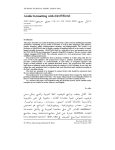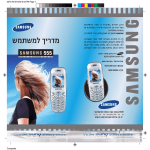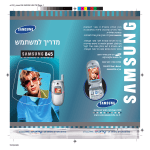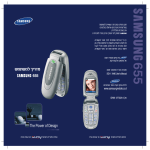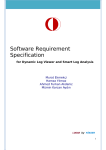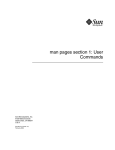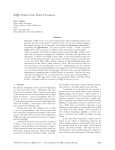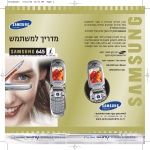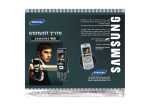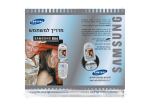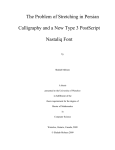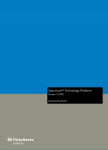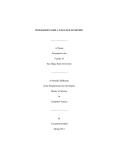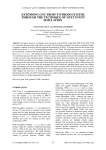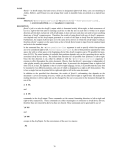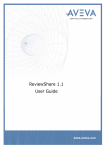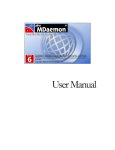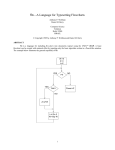Download Arabic formatting with ditroff/ffortid
Transcript
ELECTRONIC PUBLISHING, VOL . 5(4), 163–208 (DECEMBER 1992)
Arabic formatting with ditroff/ffortid
JOHNY SROUJI (Õuj¢y
)דניאל ברי
Computer Science Department
Technion
Haifa 32000
Israel
Õ¸u,
)ג’ וני סרוג’ י
AND DANIEL BERRY (k¢¹q
fא¹אN,
SUMMARY
This paper describes an Arabic formatting system that is able to format multilingual scientific
documents, containing text in Arabic or Persian, as well as other languages, plus pictures,
graphs, formulae, tables, bibliographical citations, and bibliographies. The system is an
extension of ditroff/ffortid that is already capable of handling Hebrew in the context of multilingual scientific documents. ditroff/ffortid itself is a collection of pre- and postprocessors for
the UNIX ditroff (Device Independent Typesetter RunOFF) formatter. The new system is built
without changing ditroff itself. The extension consists of a new preprocessor, fonts, and a
modified existing postprocessor.
The preprocessor transliterates from a phonetic rendition of Arabic using only the two
cases of the Latin alphabet. The preprocessor assigns a position, stand-alone, connectedprevious, connected-after, or connected-both, to each letter. It recognizes ligatures and
assigns vertical positions to the optional diacritical marks. The preprocessor also permits
input from a standard Arabic keyboard using the standard ASMO encoding. In any case, the
output has each positioned letter or ligature and each diacritical mark encoded according to
the font’s encoding scheme.
The fonts are assumed to be designed to connect letters that should be connected when
they are printed adjacent to each other.
The postprocessor is an enhancement of the ffortid program that arranges for right-to-left
printing of identified right-to-left fonts. The major enhancement is stretching final letters of
lines or words instead of inserting extra inter-word spaces, in order to justify the text.
As a self-test, this paper was formatted using the described system, and it contains many
examples of text written in Arabic, Hebrew, and English.
Ö ¯
Ó······ Ó±´ k¡אj Ö¹q¢¬ אÖ³¼ א¹¸ Àא¢q ̨ f¯אì¡א א
Ö···¹q¢¬אq Æ ë Ö¸ ,Gא³ אlN ¬ Ö¹´³ U¸¨ ¼¹¸r
,Ö········¹א¹q G¸··אyP ,G¸··אyP ,m¢··w אG··א³ Ö··אÛאq Ö··¹yPא®אj
Ó··¹¦r ¸ Àא¢о א.א¹א¢¸¹³¹qj ,Ö¹א¢¸¹³¹q PN ¨א,fjא u
lN ·····¬ Í···оאsj ç Ö···¢¬ אÖ··· ¬אë··· hо אPN א¯···אditroff/ffortid-
À······ ¬א ··¬qj (preprocessor) À·· ¬אÑ·· Ó·· lP ··אditroff/ffortid .G··א³א
Device Independent Typesetter) ditroff ,UNIX ç Ì······¨ אÀ······א¢ (postprocessor)
0894–3982/92/040163–46$23.00
1992 by John Wiley & Sons, Ltd.
Received 10 July 1992
Revised 1 February 1993
164
J. SROUJI AND D.M. BERRY
ë·· ¢·¹¹r k אf·אwN אhjN Ó· Õ·µ · אÀ·א¢ א.(RunOFF
, ······· u À· ¬אÑ· Ó· ¼·³Û אë· Ö·¸± Ö·אß א.Ò·о א¯אditroff
À······ ¬א ¬q Ó Öµ¦ Ö¦j ,Ö¹¬ªì אaj¢ אÓ Ñ אÒ¯
.Òоא
Ö····q¸± ,Ö··¹q¢ Ö··¯¹s¸ Ö··¹о¹¶ אlN··אì אÒ··u¢ À··ð¬אì אÑ··
Ñ··· .Õ··µ¹rÜ אE··אq-Ìо אç (cases) a¢··vо אÕ··¸´ f¬´··אyאq
Ö······· ¶א,Ñ···¨ ¢···¹ ,Ö···´³±אq Ô···¬¸ a¢···v Ñ···± Ó···¹¬ À···ð¬אìא
Ê········ Ѩ) Èyjj ,(i ¬q Ê Ñ¨) Öא q ,(Ô³ Ê Ñ¨)
h····א±ì אP¢··¯j (ligatures) G··א¹¢ אÓ··¹¬ ©··אо ··¸ א.(i ··¬qj Ô··³
©·····אо אÊ···¹ª¦ À···ð¬אì אÑ··· .(diacritical marks) G···א¢³ kN¸···א¬א
Arabic) Ö····¹q¢¬ אa¢vо Ö¹yא¹ Á¹r ®אÖv¸ Ó lN אѯ¦ hоא
,f··אv k אë·· .Ö··¹yא¹¯ אASMO l¢··®¹z Ñ··´¬¦r Õ··אj ,(Keyboard
Ö····¢v Ñ···±j Ö···´³± אç Ö···¹¢r j אa¢···v Ñ···± ,(output) J···אµאq
.a¢vо k¢®§ אg«אµ¦¼ אv l¢®¹z Ïאµ
Ñ······¨r a¢····vÛ אh····¾ א¹q Ö····´´¨ (font) È···· אG····א¹³±z
.m¢wо¸ א³r l v¼ א¸א±r Ó¹v gj£³ א µ ¬©¶אq
Ö········ אP¢·¯ k¡·אj ,ffortid À·א¢ Ó·¹¦r ¸· À·ð¬אì א ·¬q
Ó······¹´¹ אÓ ¼±r א¶אë Ö¢¬ì אa¢vÜ P¦א¹ אê אÓ¹´¹ אÓ
l¢··¹wо אa¢·vо( אstretching) · ¸· Õ·¦¹о¢ אÓ·¹¦ א.P¦·א¹ אêא
Ó·········¹q l ···оא£ אGא···א¢® אf···אwN אÓ··· Û ···q G´···א³± אj א¢···ªyоאq
.(justification) Ƶ אŹ´¶r a ¶q G´א³±א
,a¸·······¸ì אQ א¶אÖªy¸אq Ì
f¯אì ¡א א,Õ¦® Æ®
о
ï
,Ö······¢¬ א,Ö·¹q¢¬אq F¸·± Æ·µ l · Ö·³о אë· k¸· ¸·j
.Ö£¹³²Ûאj
ירvתק
- רבm מדעייmבמאמר זה מתוארת מערכת סדר דפוס בערבית המאפשרת סדר דפוס במסמכי
, משוואות,m גרפי,mיוריv , לשפות אחרותs טקסט בערבית ופרסית בנוסm המכילי,mלשוניי
שכבר
ditroff/ffortid
המערכת היא הרחבה של. וביבליוגרפיות,m מקורות ביבליוגרפיי,טבלאות
-m של קדsהנה אוס
ditroff/ffortid
.mלשוניי- רבm מדעייm מסמכיjמסוגלת לטפל בעברית בתו
165
ARABIC FORMATTING
Device Independent Typesetter) ditroff ,UNIX עבור מסדר הדפוס שלmמעבדי- ואחרmמעבדי
ההרחבה מורכבת בעיקר. הקיימתditroff המערכת החדשה נבנתה מבלי לשנות את.( RunOff
.mמעבד קיי- וגירסה מעודכנת של אחר,m פונטי,מעבד חדש-mמקד
m הנכתב בהשתמש רק בשני המקרי, קלט פונטי של טקסט ערביm המעבד מתרגmקד
s סו, עומד לבד, המעבד קובע לכל אות את מיקומה במילהm קד.בית הלטיני-s( של האל
liga-)
הרכבותmהוא מזהה ג
המעבד יכולm קד. (
המשתמשת בקידוד,(
cases)
.(mע )מקושר שניהv אמ,( התחלה )מקושר אחר,(m)מקושר קוד
diacritical marks)
Arabic Keyboard)
האנכי של סימני הניקודm( וקובע את המיקו
tures
קלט ממקלדת סטנדרטית של טקסט ערביmלקבל ג
לכל אות או הרכבה הממוקמות במילה ולכל נקודה יש, בפלט, בכל מקרה.ASMO הסטנדרטי
.(
font)
קוד לפי קידוד של הפונט
מודפסות האחתo כאשר הjורv שהאותיות תתחברנה ביחד במקרה הj כm מתוכנניmהפונטי
.ליד השנייה
לשמאל של אותיותo הקובעת הדפסה מימי,ffortid אחר המעבד הוא הרחבה של התכנית
(
stretching)
מתיחת
היא
העיקרית
ההרחבה
.לשמאל
oמימי
mכנכתבי
mהמזוהי
mהפונטי
ורv כדי ליm המיליo ביm נוספיm הכנסת רווחיm במקוmהאותיות האחרונות בשורות או במילי
.(
justification)
את שולי הטקסט
והוא מכיל דוגמאות, המאמר הזה מסודר דפוס בעזרת המערכת המתוארת,מיתvכבדיקה ע
. ואנגלית, עברית,רבות של טקסט הכתוב בערבית
KEY WORDS Arabic Bidirectional Formatting Multilingual Troff
1
INTRODUCTION
With computers spreading all over the world, there is a clear need for word-processing
software to be made available in languages other than English.
Basically the history is as follows. The first computers were developed in Englishspeaking countries, and the first mass-marketing of computers was in these countries.
Computers spread next to countries whose languages are written with the Latin alphabet,
but some minor fudging is needed for accents, such as ´, `, ˇ, ¨, and ¯, and for unusual
letters, such as ß, æ, Æ, ø, and Ø, which do not appear in English. Finally computers have
spread to countries with totally different alphabets, such as the Arabic-Persian family, the
Chinese-Japanese-Korean family, the Cyrillic family, Greek, the Hebrew family, and the
Hindi family. In some cases the alphabets are very large, so large that one byte is not
enough to encode all the characters. These include, of course, the Chinese-JapaneseKorean family. In some cases, the languages are written in other directions. These
include the right-to-left languages from the Arabic-Persian family and from the Hebrew
family. These also include languages written from top to bottom from the ChineseJapanese-Korean family.
For word-processing software, there is a need for formatters and editors on the batch
side and WYSIWYG processors on the interactive side.
The goal of the research that yielded the software described in this paper is to produce a complete environment for preparation, proofing, and printing of technical and
non-technical multilingual documents. We need to be able to edit, preview, and typeset
documents with all the hallmarks of technical papers including bibliographies and citations, formulae, tables, indexes, program code, and pictures. The pictures can be either
filled, line-drawn figures or half-tones. Among the line-drawn figures are plots, flow
diagrams, flow charts, graphs, trees, and data structures.
The software should be able to handle text in a wide variety of alphabets in all the
known writing directions. These include the left-to-right languages written with the
Cyrillic, Greek, Hindi, and Latin alphabets, the right-to-left languages written with the
166
J. SROUJI AND D.M. BERRY
Arabic, Persian, and Hebrew alphabets, and the top-to-bottom languages written with the
Chinese, Japanese, and Korean alphabets. Any alphabet not specifically listed should not
be construed as excluded.
The software should work in the increasingly popular UNIX environment. The main
reasons for this requirement are that
1. the authors’ various organizations are all UNIX shops, and
2. there is a variety of existing software in source form that solves most of the problem
and that can be reused to provide significant leverage towards a full solution.
Software exists on UNIX environments that is capable of previewing and typesetting
technical and non-technical documents with bibliographies and citations, formulae,
tables, indexes, program code, and pictures, both line and half-tone, in all the known
writing directions, left-to-right, right-to-left, and top-to-bottom, with a wide variety of
fonts for Latin-based, Chinese-based, and Hebrew-based languages; some of this
software is used to typeset articles for this journal. The specific goal of the work
described in this paper is to extend this formatting software to be able to format such
documents containing text in the Arabic-Persian family of languages. Because the first
author is a native Arabic speaker, the focus of this work is on Arabic. Attention is paid to
handling Persian and Urdu when possible, and if not, then at least to not excluding later
extensions to handle them by native experts.
Given that a self-test has become de rigueur for formatting papers, this paper was
typeset using the software described herein, using the command lines
refer -e -n -p ˜/.refsidx paper > paper.ref
psfig paper.ref | sed -f cross.reference | \
chem | pic | atrn -b -l0 | tbl | eqn | \
troffort -r13 17 22 42 -a42 -sa -IhD -IAN -t > paper.ps
What is new in this command line are the invocations of atrn, for Arabic transliteration
preserving the original line breaks (−b) with ligature level 0 (−l0), and of troffort, for
bidirectional formatting with the fonts in positions 12, 17, 22, and 42 specified as rightto-left and the font in position 42 specified as Arabic with stretching of all words (−sa)
and inclusion of the POSTSCRIPT definitions of fonts hD and AN.
Most of the figures were done with pic, tbl, eqn, chem, or pure formatted text. Figure 4 was scanned in and converted to encapsulated POSTSCRIPT with the help of Adobe
Illustrator. Figures 5 and 6, and the example involving writing a complete word on top of
a stretched letter, are manually programmed encapsulated POSTSCRIPT documents. All of
these encapsulated POSTSCRIPT documents are included into the paper with the help of
psfig. The document included in Figure 5 uses an experimental dynamic font. The reason
Figure 6 was included via psfig rather than typeset as normal text is that providing the
five Arabic fonts to typeset it normally makes the POSTSCRIPT document sent to the
printer too big. By preparing it as a separate encapsulated POSTSCRIPT document, it was
possible to whittle the fonts down to just what is necessary to make the figure. The
second and third of the stretching examples of Section 8.2.4 are typeset as separate documents with the described software, because only one kind of stretching can be in effect
ARABIC FORMATTING
167
for all Arabic fonts in a single document. Their POSTSCRIPT outputs are interpolated into
that of the main document by use of an editor.
Details omitted from this paper owing to space limitations are in a complete technical
report of the same title available from the second author.
2
ARABIC LANGUAGE AND ITS FORMATTING PROBLEMS
2.1
Arabic language and computerization
The Arabic language is the main language in the Middle East, the mother tongue of about
200 million people in 21 countries, one of the five official languages of the United
Nations, and one of the two official languages in the state of Israel, where the authors
live. Moreover, the same alphabet is used, with minor changes, both additions and subtractions, in several other languages including Persian, Kazak, Kirghiz, Malay, old Turkish, Uighur, and Urdu. The geographic influence of the language is widespread.
There has been a large effort in recent years to bring the benefits of computerization
to the Arabic world. This Arabization effort, described in a variety of papers in recent
conferences in the Middle East and elsewhere [1–5], has yielded hardware that can store,
read, print, and enter Arabic, Persian, Kazak, Kirghiz, and Uighur text [6, 7]. It has also
yielded databases, spreadsheets, and word-processing applications, that can work with
the same [7, 8].
2.2
Arabic alphabet and implications for processing
Arabic is an ancient language that originated from the Aramaic language that was used
by the Nabateans and, like the other languages of Semitic origins, such as Hebrew, it is
written from right to left. However, numerals1 are written with the most significant digit
to the left (i.e., what is commonly called from left to right).
2.2.1
Letters that connect and change form
In Arabic and related languages, the shape of letters depends on their positions within
words. In Hebrew, in which characters are disconnected, only five letters change form
according to their position within a word, and they change form only when they are last
in a word. In Arabic, letters are written mostly connected and, as a consequence, nearly
all letters change form according to position within a word. There are up to four different
forms for each letter, namely, stand-alone, connecting-before, connecting-after, and
connecting-both. The forms adopted by the letters are quite natural for the hand to produce when the hand is writing in a continuous flow. Therefore, for a fluent writer, the
positions just happen as the letters are being written, much the same way as the lead
stems of Latin letters change to accommodate a preceding “o” without the writer really
having to think about it.
The Arabic alphabet consists of 31 letters and five vowels (see the table of Appendix
II). Because the letters alef, taa_marbouta, and alef_maksura are really other versions of
1
The designation of the standard numerals written in Latin alphabetic text as Arabic is misleading, as these
numerals bear no resemblance to those actually written in the Arabic language.
168
J. SROUJI AND D.M. BERRY
other letters, grammatically there are only 28 letters. Thus, the table of Appendix II
shows the Arabic alphabet as it must appear to any formatting software that is obliged to
treat different versions and forms of the same grammatical letter as different characters
and that is obliged to treat a diacritical mark as a character. It also has the additional
characters that are needed to print Persian and international text.
The table of Appendix II also shows the different forms for each of the letters. Most
letters have four forms. The four forms of the letter F, which are F, ¼, q, and ,
appear in the words Fא, ¼
î îî, ¢q, and hאu. There are letters, e.g., N, that
naturally do not connect to the following letter because of where they end. These letters
have only two forms, stand-alone and connecting-before. Operationally, it will prove
convenient to treat all letters as having four forms. In the case of a two-form letter, the
connecting-after form is made a duplicate of the stand-alone form and the connectingboth form is made a duplicate of the connecting-before form.
2.2.2
Diacritical marks
The use of diacritical marks or vowels in Arabic, as in Hebrew, is optional. In normal,
everyday text, a diacritical mark would be used only in the rare case in which it would be
hard to identify the intended word from the letters and the context. For example, consider
the word ¼ written without diacritical marks. It could be either ¼
î ((he) wrote) or
î î
¼ï
(book). Normally it is quite easy to distinguish which of these is intended by the
ò
position in a sentence. The former is a verb and the latter is a noun. There is other text,
either poetry or books for children, in which a full complement of diacritical marks is
used. In the former case, word order is often inverted, and in the latter case, the young
readers do not know the contexts.
A diacritical mark is written either above or below the letter after which its vowel is
pronounced and also affects the accent or stress of that letter. Figure 1 shows the Arabic
letter N with all the possible vowels. Below each is its pronunciation expressed in Latin
letters. The input of diacritical marks should be allowed, and each should be printed
N
î
N
ï
ðN
N
ñ
N
ò
óN
N
ô
da
du
di
dan
don
den
d
N
о
N
о
N
û
N
о
N
о
N
þ
N
õ
dda
ddu
ddi
ddan
ddon
dden
dd
Figure 1. Vocalizations of one letter
at the proper height above or depth below the letter that it follows in pronunciation. Here
the proper height or depth is determined by the bounding box of the letter itself.
A glance at the table of Appendix II shows that some letters differ graphically from
others only by the addition of some dots. These dots are part of the letters and should not
ARABIC FORMATTING
169
be considered diacritical marks. In fact, to the formatting software, these dots are
irrelevant. Only to the font software might these be relevant, as glyphs might be built by
calling subroutines that draw the different parts.
2.2.3
Ligatures
Arabic has ligatures, i.e., characters created by merging at least two others. The most
common ligature in Arabic and its sibling languages is the Û (lam-alif) created by merging the f (lam) and the ( אalif). Grammatically, the lam-alif is not a letter; it is two
letters, and words containing it are treated grammatically as containing a lam followed by
an alif. A ligature is created and used solely to improve the calligraphic appearance of the
text. Therefore, strictly speaking, forming ligatures is optional. The lam-alif is the most
common ligature and is used in place of the individual letters in sequence virtually every
time. It has become, for all practical purposes, obligatory. One section of the table of
Appendix II lists the ligatures supported by this software. The optional ligatures, e.g., í
(lam-mim), formed from the f (lam), and the g (mim) are used less frequently. Figure 2
shows, in the last steps of lines (a) and (c), words involving the ligatures lam-mim and
lam-alif. In the figure, the gf is recognized as a ligature in (a), and is not recognized as
a ligature in (b). Because the lam-mim is only an optional ligature, either is acceptable.
The אf is recognized as a ligature in (c) as is required. Were it not to be recognized as a
ligature, as in (d), one would obtain an impossible word containing the unacceptable construction א.
Obviously, the formatter must treat a ligature as a separate character to be printed as
any other letter. Typeset Latin text has ligatures, the most famous being “fi” which is
used to avoid the two ugly, beady eyeballs staring at the reader when the ligature is not
used, viz. “fi”. While the reader reads the “fi” as two letters, “f” and “i”, the formatting
software considers the “fi” as another character. Of course, most formatting applications
that provide ligatures do so automatically; the user enters “f” followed by “i” and the
software replaces them, if they are still together after hyphenation, by the ligature character “fi”. Any Arabic wordprocessing software worth its salt should provide a similar service. Accordingly, Figure 2 also shows the steps in arriving at the final form of two
words involving the ligatures lam-mim and lam-alif.
Arabic has an interesting property in connection with the optional ligatures. Assume
that it has been decided for a document to form a ligature for a particular ordered pair of
letters. Then sometimes, whether that ligature is formed in a particular place depends on
the positions of the two original letters in the word. Take, for example, the optional
lam-mim ligature formed from lam and mim. The lam and mim are joined into a unit only
when the lam stands in a connected-after position and the mim is in a connected-before
or a connected-both position. This is because the lam-mim is available only in
connecting-after and stand-alone forms. See Figure 3 for the four cases of the ordered
pair, lam and mim. gf is recognized as a ligature only in the first two cases.
170
J. SROUJI AND D.M. BERRY
g J P G g f → אÒ u ¢ ì → אÒu¢ìא
h hh
h
(a)
h
g J P G g f → אÒ u ¢ ´ → אÒu¢´א
h hh
h h
(b)
hh
f S אf S → Ñ y Ü y → ÑyÜy
h hh
(c)
hh
hh
f S אf S → Ñ y א³ y → Ñyא³y
h hh
(d)
h h
h
Figure 2. Steps of ligature identification
Ò →í
´ →ì
Ò ³ → Ò³
´ ³ → ´³
Figure 3. Four cases of the lam-mim combination
2.2.4
Justification, hyphenation, and stretching
In Arabic, typeset text is usually right and left justified. However, there is no hyphenation
that can be used to make the job easier. The reason that there is no hyphenation is that
hyphenation would mess up the whole positioning system causing two internal letters to
behave as ending and beginning letters of words, causing a very strange appearance of
the letters in what might be a very familiar word.
For languages with non-connecting letters, the usual method to achieve justification
on both sides of a line is to insert extra white space in between words so that the list of
words that will fit on a line are spread out to be flush at both ends. Usually the spacing
between words is constant for the line, but sometimes extra white space is put after the
end of a sentence. In addition, some algorithms, e.g., for TEX [9], try to make the spacing
uniform over larger units of text than just the line. In Arabic, in contrast, the more usual
treatment is to stretch the last letter or the approach to the last letter if that letter or
ARABIC FORMATTING
171
approach can be stretched. This stretching is called l ¹§ (keshide). “Keshide” is
actually a Persian word derived from the verb h ¹§ (keshidan), which means “to
stretch”.
There appear to be no formal laws specifying when, how, and how much to stretch
letters. Instead, calligraphers decide to stretch according to aesthetic considerations.
Basically stretching of last letters happens because a calligrapher writing with ink cannot
predict the spacing to use between words until he or she reaches the end of the line; at
that point there is nothing left to do but stretch the last letter. Someone who is writing
with ink does not have the lookahead that a computer does! Lack of lookahead notwithstanding, examples in Section 8.2.4 later in the paper, show that stretching in Arabic is a
natural thing and yields a nicer appearance than does spreading the words.
There are two main ways to stretch. One way is to stretch the connection to the
letters. As an example, the word Ö········µ אis obtained by stretching the connection to
the letter Ö in the word Öµ אby 12 points. The other way to stretch is in fact to stretch
the letters themselves. Generally, only those letters with large, mostly horizontal, strokes,
such as d, e, a, c, b, F, G, H, d, I, f, S, T, U, V, h, k,
and m, are stretched. Figure 4, taken from an Egyptian text on Arabic calligraphy [10, 11], shows the letters F, a, and a variation of e, with and without stretching.
The unstretched versions of the letters are said to be 5 points wide (the point is the width
of the dot that appears in two of the letters), and the stretched versions are 11 points
wide. This figure also shows the importance of aesthetics in stretching, an importance
that precludes clear laws. Because the three letters that are stretched are structurally similar, for appearance’s sake, they had to be stretched the same amount rather than individual amounts according to the needed justification. For this kind of situation, the human
calligrapher must exercise lookahead.
In manual calligraphy, the preference is for stretching letters themselves, but both
methods of keshide are used. Some letters, i.e., those with no horizontal part, e.g., א, are
just not stretchable. It is sometimes not aesthetic to stretch a particular letter. On the other
hand, sometimes the last letter is not connecting-before, so there is no connection to
stretch. If both happen in the last word of a particular line, then the next-to-last letter or
its connection might be stretched.
In electronic publishing with the standard kind of fonts that are available, the current
preference is for stretching the connection to a letter, because if the letters connect at the
same baseline, it is easy to provide a filler situated at the baseline, touching both vertical
boundaries of the bounding box and as wide as the standard stem of the letters. Figure 5
shows the connecting-after and the connecting-before forms of the letter F connected
without and with one such filler between them in lines (b) and (c) respectively. line (a)
shows how a connecting form of a letter meets its bounding box on the connecting side
and how there is white space between a letter and the bounding box on the nonconnecting side. Stretching a letter itself requires a dynamic font in which the width of a
character may vary from showing to showing, even though its point size and stem
172
J. SROUJI AND D.M. BERRY
Figure 4. Non-stretched and stretched letters
thickness may not change. André [12] shows how to make such fonts, and we are in the
process of making a dynamic version of the font used herein. lines (d), (e), and (f) of Figure 5 were printed using a dynamic, parameterized version of the connecting-before form
of F, for which the parameter of the glyph is the additional width. The three lines were
obtained with the parameter being zero, the width of one dot (the diamond under the
letter), and twice the width of one dot, respectively. Unfortunately, however, a document
filled with such characters takes forever to print, because character cacheing has to be
turned off to allow the bitmap of a character to be computed each time it is printed.
2.2.5
Calligraphic styles
Arabic is famous for its various beautiful calligraphic styles. The differences between the
styles is in the way of writing the letters and in the amount of overlap between neighboring characters. Some of the styles even permit the writing of complete words on top of
the last letter of the previous word. A shining example of this is the assembly of the two
words b followed by Úא. It is customary to write the Ú אon top of a stretched b
to yield:
b
Úא
In electronic publishing, this sort of thing can be done if the font being used has the construction available as a single, special character or if the characters making up the construction can be algorithmically distorted to the right shape to be used as pieces to build
the construction.
Over the past thousand years, a number of calligraphic styles have grown in popularity and are quite standard these days. These include the fonts listed in Figure 6. The main
Arabic font used in this paper is Naskh. In the figure, if we have a font available for the
calligraphic style, we use it to write its own name; otherwise we use Naskh. Such a
¼ q
¼q
¼·q
q
q
q
ARABIC FORMATTING
(a)
(b)
(c)
(d)
(e)
(f)
Figure 5. Connecting letters, fillers, and dynamic letters
173
174
J. SROUJI AND D.M. BERRY
default use of Naskh is marked in the figure with an asterisk. The available fonts can be
used with ditroff/ffortid; it was required to reorganize these fonts to have the same
encoding for the glyphs as does the Naskh font.
Baghdadi — Íœ«bG
Farsi * — ÕyPא
Diwany * — Õ¸אN
Geezah —
Kufi —
…eO
wu
Nadeem — .b
Naskh — ¦
Requ’ah * — Ö¬P
Tholoth * — ¾³s
Figure 6. Calligraphic styles
2.2.6
Character codes
In the computerization efforts for Arabic and Persian, standards have emerged for codes
for letters. Therefore, it is possible now to insist that the code for each letter in each
language accepted by any processor should be according to one of the standards for that
language. For Arabic, this code should be ASMO, for Persian, this code should be ISCII,
for Hebrew, this code should be ESCII, and for English, this code should be ASCII.
3
GENERAL REQUIREMENTS FOR ARABIC FORMATTING
On the basis of the above discussion, it is possible to state the requirements for a multilingual formatting system that formats Arabic.
1.
2.
3.
4.
Solve all of the Arabic processing problems mentioned in Section 2.
Be user-friendly.
Produce book-quality output.
Whatever processing, e.g., identifying positions of letters, can be automated should
be automated. Whatever should be left to the user, e.g., deciding on the level of
ligaturing, is left to the user.
5. Permit formatting of scientific and technical text and all of the document entities
that go with them, including formulae, tables, graphs, etc.
ARABIC FORMATTING
4
175
SOFTWARE ENGINEERING ASPECTS
Our motto is, “A good software engineer is a lazy one!” An existing formatting system
should be used as much as possible. It is good if the new software is user-level compatible with the old; it is better if existing code is modified to obtain the new software; it is
best if existing code is externally extended to obtain the new software.
Given that the authors’ preference is a UNIX environment, then the question to ask is
what complete formatting environments exist on UNIX platforms? These can be divided
into two classes: WYSIWYG (what you see is what you get) and batch. Examples of
UNIX-based WYSIWYG formatters with the most functionality are Interleaf [13] and
FrameMaker [14]. The problem is that WYSIWYG formatters are of necessity monolithic programs. All their processing must be in the main program. They are interactive and
must compute a new image of the document after each editing change. As a consequence
they cannot make use of pre- and postprocessors to do some of their work. Adding new
features requires opening up the main program and adding the new features in the midst
of all existing functionality, and we do not have access to their source code.
The serious candidate batch systems were ditroff [15] and TEX [16, 17]. They have
sufficient basic functionality for doing scientific documents, although, for reasons to be
explained later, there is a serious deficiency in the latter. Both ditroff and TEX have been
extended, albeit in different manners, to handle bidirectional text.
Figure 7 shows the flow of the current ditroff System with all pre- and postprocessors
known to these authors. See References 18 through 36 for more details on each. This
system offers hope of implementing new functionality simply by inserting new pre- and
postprocessors. This hope arises from the UNIX philosophy of having separate language
processors for each language, each understanding part of the job, and leaving all the rest
to the others. Here, “language” means not only natural language, but also a notation for
expressing some unit of the document, such as a formula. Each processor is easily
modified independently of the others. Best of all, existing pre- and postprocessors and
macro packages continue to work as each new processor or macro package is added!
There is also an economic issue involved. By adding new features via new, separate processors, no source license is needed for ditroff. All that is needed to write a pre- or postprocessor is the specification of the input or output of ditroff.
The bidirectional version of ditroff, ditroff/ffortid, was built in this modular manner
by adding a postprocessor, ffortid, to an unchanged ditroff. ffortid is responsible for printing right-to-left text from right to left, while ditroff treats all text as if it were written
from left to right. Because ditroff was not modified at all, all ditroff preprocessors and
macro packages work for ditroff/ffortid. Moreover, since ffortid output looks like ditroff
output, all ditroff postprocessors work for ditroff/ffortid.
The question is, “Why not TEX?” Why do we insist on using old-fashioned, braindamaged troff technology? TEX also suffers from the same sort monolithism as are
suffered by WYSIWYG systems; all of the table and formula processing are part of the
main program. TEX is not really pipeable, so use of pre- and postprocessors is inconvenient. There are more serious problems, problems of inadequate information, that are
discussed fully in Section 10. As a result of these problems, TEX’s bidirectional version,
TEX/XET [37] has to be built as a modification of TEX and not simply by adding a postprocessor to an unmodified TEX, as was done to obtain ditroff/ffortid from ditroff.
176
J. SROUJI AND D.M. BERRY
chem
dag
dformat
drag
dotchart
file
psfig
refer
et_al
grap
pic
tbl
eqn
alg*
scatmat
flo
music
macros
index
terms
swizzle
dtroff
screen
indx
ffortid
bditroff
pm
psdit
laser
printer
photo
typesetter
Figure 7. Flow of ditroff system
5
EXISTING SOLUTIONS
A number of word-processing and computing systems have been built for Arabic and
related languages. The work that has influenced ours is described here.
1. An experimental bilingual, Arabic and English, system called IAS (Integrated Arabic System) was built on the IBM PC by a group led by Murat Tayli at King Saud
University [38, 39, 6]. The IAS system was built around the kernel of the IAW
(Intelligent Arabic Workstation) and its operating system with the addition of
software tools that assist in writing new applications.
2. A WYSIWYG system for processing Arabic, Hebrew, English, and a host of other
languages was built by Becker [40, 8] to run on the Xerox desktop publishing system. The system identifies the type of each character as it is being printed and
chooses its printing direction on that basis. In other words, the system knows from
the beginning that Arabic and Hebrew are printed from right to left and English is
printed from left to right. There is the choice of two document directions, from left
to right and from right to left. The document direction is that of the language in
which most of the document is written or the language designated as the main
language of the document. The screen appearance is calculated on the basis of the
directions of the characters displayed and the current document direction.
3. The TARIF system [41] was developed at the University of Montpellier, running on
an MC68000 microprocessor with a high-resolution graphic screen and a laser
ARABIC FORMATTING
4.
5.
6.
7.
177
printer, and was written in Pascal on an MS-DOS system. The system has two main
parts. The first part is the editor which has the job of accepting Arabic textual input
and showing it on the screen with each letter’s form changed to match its position in
its word. The second part is a formatter whose job is to arrange the text with
keshide. The stretching is not in the form of longer connections between letters, but
rather by use of long-form letters. This is accomplished by breaking each letter into
three parts, the right, the left, and the middle. The short form of the letter is made by
concatenating the right and the left part. The long form of the letter is made by
inserting one or more middle parts in between the right and the left parts. This
requires careful design of the pieces of the letters and works well only with fonts
whose letters have perfectly flat horizontal parts. This would not work well with
fonts whose characters have curved horizontal parts, such as that illustrated in Figures 4 and 5 above. It is not known from the available documentation if the system
is multilingual with bidirectional processing and whether it can handle scientific
text.
The IBM Scientific Center in Kuwait has developed a bilingual, Arabic and English,
word-processing system [42]. The problems are handled in two parts. The first part
was the generation of an Arabic font in the Naskh style in three different formats, an
outline font and two bitmaps for different resolutions. The second part is a bilingual
text processor that includes an Arabic language editor that sets the lines with
keshide and takes care of placing vowels correctly. The system is not for preparing
scientific text.
Y. Haralambous [43] has developed an Arabic TEX system composed of the standard unidirectional TEX and a preprocessor called yarbtex. yarbtex transliterates
phonetic Arabic text into the input format required by TEX augmented by J.
Goldberg’s bidirectional style [44] that reverses the printing of text surrounded by
pairs of special symbols. Haralambous uses a Naskh font which is in a format
acceptable to TEX and its dvi postprocessors. This system is multilingual and
bidirectional to the extent that TEX and Goldberg’s system are. However, there is no
provision for keshide.
The most ambitious TEX-based project aimed at formatting Arabic is the TEX/XET
program developed at the initiation of P. MacKay by modifying TEX itself to be
bidirectional [37]. The program does the same reversing of text in designated
right-to-left fonts that ffortid does, but inside the modified TEX using the internal
data structures of the program rather than the dvi output. It assumes separate letters
as TEX does and does nothing about stretching. TEX/XET was designed to be
language-independent, and is in fact being heavily used for Hebrew processing in
universities in Israel. It has become a strong competitor for ditroff/ffortid in this
respect. Clearly, TEX/XET can handle all the scientific text that TEX can. It was
always intended by MacKay that TEX/XET be used for Arabic and it in fact appears
to be the version of TEX upon which Haralambous’s latest system is based.
Haralambous upgraded yarbtex into a full-scale multilingual formatter called
SCHOLAR TEX that comes with a very complete set of fonts. Besides being able to
format Arabic, it can format Persian, Ottoman Turkish, Pashto, Urdu, Malay, classical Hebrew, modern Hebrew, Yiddish, Syriac, and others, both left-to-right and
right-to-left [45]. It appears to be based on TEX/XET and is thus fully bidirectional.
178
J. SROUJI AND D.M. BERRY
TEX/XET and the current ditroff/ffortid are only partial solutions to the requirements
for Arabic word-processing laid down earlier. Neither system is able to handle all of the
requirements that stem from Arabic’s connecting, changing, and stretchable letters.
6
DITROFF/FFORTID
The current version of ffortid, which has been used for years for formatting Hebrew, is
quite a simple program. ffortid is stuck into the ditroff pipe between ditroff and whatever
device driver is being used. ditroff has already formatted all the input on the assumption
that all input is in left-to-right languages. The input has been broken into lines and pages
according to the commands embedded in the input. Generally the lines are both left- and
right-justified with words spread farther apart on a line-by-line basis to achieve the double justification. Whether or not the output is justified is controlled by user-issued commands.
The main job of ffortid is to take as input the output of ditroff and rebuild an output in
the same format. The output is to be a formatted document in which all text in designated
right-to-left fonts is printed in what appears to be from right to left. The right-to-left font
positions are indicated by command-line options on the command invoking ffortid. At
any time, there are two independent state variables that govern the rebuilding process of
ffortid. One is the current document direction, which is either LR (left-to-right) or RL
(right-to-left). It is settable at any time via the “x X PL” and “x X PR” commands,
respectively, in the ffortid input. There are ditroff macros, “.PL” and “.PR”, respectively, that cause the right commands to be left in the ditroff output, which is the ffortid
input. Initially the current document direction is LR. The other variable is the current font
direction, i.e., the writing direction of the current font. It is RL if the current font of the
text is one of the fonts that has been designated right-to-left to the current run of ffortid
and is LR otherwise.
The heart of the ffortid algorithm is a layout algorithm that operates on a line-by-line
basis.
for each line in the file do
if the current document direction is LR then
reverse each contiguous sequence of RL characters in the line
else (the current document direction is RL)
reverse the whole line;
reverse each contiguous sequence of LR characters in the line
fi
od
An RL (LR) character is a character in any RL (LR) font. This algorithm is also the basis
of processing right-to-left text in Becker’s multilingual Xerox desktop publishing system,
in Knuth and MacKay’s TEX/XET, in Habusha’s vi.iv [46], and in Allon’s
MINIX.XINIM [47]. The algorithm is now accepted as the way to handle horizontal
bidirectional text in software originally designed for strictly unidirectional processing and
in new software designed for horizontal bidirectional processing on the assumption that
all text is stored in time order, i.e., the letters are stored in the order they are heard when
the text is read aloud.
ARABIC FORMATTING
179
Note that this algorithm preserves line breaks and the nature of indentation and
justification on each line, relative to the current document direction. That is, if the current
document direction is LR, then indentation and justification is exactly as in the original,
and if the current document direction is RL, then the indentation is on the opposite side
and justification is flipped, e.g., if the original is right-justified, then the result is leftjustified. For the purposes of this algorithm, a space is regarded as a character and its
font, and thus direction, must be identifiable. In addition, formulae, tables, and pictures
are considered LR subdocuments that may contain RL text internally. That is, even if a
table contains Hebrew text, the table skeleton itself is an LR unit.
7
STILL TO BE SOLVED
By using ditroff/ffortid as the basis for the solution, many aspects of the requirements are
already satisfied. Specifically,
1. There is horizontal bidirectional formatting and proper treatment of paragraphs,
pages, and documents. It is possible to turn off hyphenation over any portion of the
formatted text.
2. The system is user-friendly, at least insofar as ditroff and its pre- and postprocessors, and macro packages are considered user-friendly.
3. The system does produce book-quality output when used with a printer of sufficient
resolution.
4. The system permits formatting of scientific and technical texts and all of the usual
document entities that are found in them, including formulae, tables, diagrams,
graphs, bibliographical citations, etc.
Yet to be solved are those requirements related specifically to Arabic and Persian formatting, including
1.
2.
3.
4.
5.
6.
connecting letters,
different forms for each letter,
position identification,
ligature identification,
vertical placement of diacritical marks, and
keshide.
It was decided to handle these as follows.
1. An Arabic font would provide the different forms of each letter as independent
characters and each character that is to be connected on any side would be designed
to be flush to the bounding box on that side at precisely the same place relative to
the baseline. lines (a) and (b) of Figure 5 show how letters in such fonts connect.
2. A preprocessor, called atrn, would do letter form and ligature identification on
letter-only input to yield output with each glyph to be printed, be it a form of a letter
or a form of a ligature. The letter-only input would be according to a standard
encoding for the language being processed, and the output would be according to
the font’s encoding for the glyphs. Thus, ditroff would format input consisting of
the glyphs to be printed. If the input to the preprocessor has diacritical marks, then
180
J. SROUJI AND D.M. BERRY
they will be translated into their glyph codes surrounded by instructions to place
them in the proper vertical position with respect to the character with which it is
associated.
3. The ffortid postprocessor would be modified to stretch connections to last letters of
words and/or lines in order to achieve one kind of keshide.
8
SOLUTION
As mentioned, the solution consists of creating a new program, atrn, and modifying an
existing program, ffortid.
8.1
The atrn transliterator
The new program, atrn, is a ditroff preprocessor. Its main function is a mapping from
pure spelling into a string of properly vertically and horizontally placed glyph codes,
each one representing a letter or ligature, positioned within its word, or a diacritical mark.
The pure spelling input is either in the standard encoding of the language or in some
Latin, possibly phonetic, rendition of the same.
For Arabic, the input would be a string of letters in the ASMO code minus the lamalif, plus codes for the vowels that are distinguishable from the codes for the letters.
Since the ASMO code has only one code for each letter as opposed to up to four for each,
it is clear that ASMO is intended to support automatic position identification and assignment. Because it does have a lam-alif, it does allow a user to force the use of a lam-alif.
However, we insist on fully automated ligature identification based on user-selected
options and on giving the user a way to prevent the ligature from being formed in any
particular case. ASMO does have codes for some vowels but not for all, so we have to
add codes, in the form of ditroff two-character special characters, for the other vowels.
For uniformity, such codes are introduced for all the vowels, even the ones that happen to
be represented in the ASMO code. Thus, for Arabic input in the extended ASMO code,
atrn does position identification, ligature identification, and diacritical placement.
For each language supported by atrn, the mapping translates its standard encoding to
glyph codes according to the fonts being used. Of course, this means that all the fonts for
each language should use the same glyph encoding. Sometimes assuring this uniformity
requires changing the Encoding vector of POSTSCRIPT fonts from different font foundries. As specified, atrn should accept input from standard input devices for the
language. However, such devices are not always available, and no Arabic, Persian, and
Urdu keyboards were available to the authors at any place that they worked. Therefore, it
is convenient for atrn to also provide for translation from Latin keyboard input based on
some phonetic or other mapping from Latin letters to the standard code for the language.
This feature permits input of the pure spelling and vowels phonetically using the universally available Latin keyboard.
The flow of atrn is shown in Figure 8. The section below explains the order of the
translations, in particular why ligature identification must come first. Each translation in
the atrn flow is table-driven to allow the actual codes used to be changed easily.
Each language and each translation step is considered in more detail.
181
ARABIC FORMATTING
Latin
text
ligature
identification
transliteration
to alphabet
code
if necessary
ASMO
coded
text with
ligatures
vowel
placement
position
identification
translation
to glyph
codes
output
ASMO
coded text
Figure 8. Flow of atrn
8.1.1
Input to the transliterator
The transliterator is structured to be a general transliterator for all kinds of phonetic input
for languages in the Arabic-Persian family. If a table defining the transliteration can be
built, then it can be integrated into the transliterator, which selects which table it uses as a
function of the argument to the %S command described below. At present, however,
only Arabic translation is supported.
The purpose of the transliteration phase is to allow someone who does not have an
ASMO code generating Arabic terminal to prepare input to be formatted. Therefore, the
code used for the alphabet to which the phonetic input is transliterated is ASMO. Therefore, a user with an ASMO-generating keyboard needs to skip only this phase; the other
phases that determine positions, ligatures, and vowel placements cannot be skipped.
Thus, one of the options to atrn is not to translate its input at all. This scheme can be
used to provide any pre-formatting processing to any input language regardless of the
input keyboard.
The word ¼ for example, is represented by the phonetic input ktb. Below is the
phonetic input of the first paragraph of the Arabic abstract of this paper. %Sar marks the
beginning of phonetic Arabic text, and %Ear marks its end. The text is shown with all of
the embedded ditroff commands: .OA means “other abstract header”, .lp means “left
adjusted paragraph”, .PP means “indented paragraph”, \*(AN means “switch to AN
font and change size as necessary”, \*P means “switch to previous font and change size
as necessary”, \*H means “switch to Helvetica font and change size as necessary”, and
\*R means “switch to Times Roman font and change size as necessary”.
182
J. SROUJI AND D.M. BERRY
.OA %Sar\*(AN\s+2mqdmt‘\s-2%Ear
.lp
%SarHZa almqal ySf brnamj ltwDyb allR‘t‘ alerbyt‘ walZy ymkn mn
twDyb nSwS elmyt‘ mteddt‘ allR‘at, mhtwyt‘ elA‘ nS balerbyt‘
walfarsyt‘ balaDaft‘ llR‘at axrA‘, rswmat, rswmat byanyt‘,
jdawl, mSadr byblywR‘rafyt‘, wbyblywR‘rafya. Albrnamj Hw thsyn
lI-%Ear\*Hditroff/ffortid\*(AN%Sar alqadr ala˜n elA‘ mealjt‘
alebryt‘ fy wcaY‘q mteddt‘ allR‘at.
%Ear\*Hditroff/ffortid\*(AN%Sar ebart‘ en qbl mealj
%Ear\*R(preprocessor)\*(AN%Sar wbed mealj
%Ear\*R(postprocessor)\*(AN%Sar lbrnamj alSf fy
%Ear\*HUNIX\*(AN%Sar, %Ear\*Hditroff \*(AN%Sar(%Ear\*RDevice
Independent Typesetter RunOFF\*(AN%Sar). albrnamj aljdyd mbny
mn dwn idxal ay tR‘yyr elA‘ %Ear\*Hditroff\*(AN%Sar alqaY‘m.
aliDaft‘ mkwnt‘ elA‘ alaR‘lb mn qbl mealj jdyd, Tqm kaml mn
alhrwf almTbeyt‘, wnsxt‘ mhsnt‘ mn bed mealj qaY‘m.
.PP
The Latin letter chosen to represent any Arabic letter is one whose pronunciation reminds
the user of a pronunciation of the Arabic letter. It would be best to have a unique onefor-one mapping. However, this is impossible. From the point of view of accurately
representing what the user must choose, there are 42 letters and 17 diacritical marks
(vowels) to be represented by 52 characters (upper and lower case). Moreover, there are,
in some instances, more than two Arabic letters that can be feasibly represented by the
two cases of one Latin letter. As a consequence, it is sometimes necessary to map two
ASCII characters to one Arabic letter. When more than one Arabic letter is feasibly
represented by one Latin letter, the lower-case letter goes to the most frequent Arabic
letter, the upper-case letter goes to the next most frequent, and the two-letter codes go to
the least frequent, etc. The idea is to minimize typing time. When a two-letter code is
used, it is critical to make sure that the second letter be chosen so that it is not a valid
representation of any letter in its own right, so as to insure unambiguous recognition. In
other words, since h is the code for a letter, it cannot be used as the second letter of
another letter’s code, e.g., kh for khaf, as is commonly used for phonetic renditions of
Arabic for human consumption. The table of Appendix II shows the phonetic mapping
implemented by atrn for Arabic and Persian letters.
8.1.2
Output of the transliterator
Our system prints the Arabic text on a laser printer with high-quality POSTSCRIPT outline
fonts. The first font that we had available for use was the Naskh font produced by Draper
and Parkins. It was necessary to make a few modifications and additions. The main
modifications were to give new codes to the glyphs and to make the internal names of the
characters more mnemonic than the standard Adobe names given to the codes. For example, taa_SA is more meaningful than Adieresis. The names given to the glyphs were
the same used in the second table of the transliterator. While these names are in the last
analysis merely internal to the programs, making this agreement helped the first author
keep his sanity when debugging the software. It was also necessary to add seven new
183
ARABIC FORMATTING
characters to the font to give it the capability of printing the standard international punctuation that appears in nearly every standard coding of an alphabet, the ASMO code as
well! The characters &, @, ˆ, {, }, |, and ˜ were added by lifting outlines for them from
a public domain Hebrew font whose other international characters looked most like the
international characters that the Arabic font did have. The new codes were assigned so
that the international standard characters kept the code that they have in nearly all standard code sequences. Then the glyphs for Arabic, in all forms of all letters, were assigned
to the rest of the table so that within the section of glyphs for one position, all the glyphs
are in alphabetical order. Thus, the stand-alone glyphs got codes 102–160 (octal),
connect-after glyphs got codes 161–224, connect-both glyphs got codes 225–273, and
connect-previous glyphs got codes 274–331. The ligatures got the codes 322–355, and
the diacritical marks got the codes 356–376. In order that the output be acceptable as
input to ditroff, the transliterator used the absolute index escape to name each glyph by
its code. That is each glyph is addressed by the escape \N’xxx’ where xxx is the decimal
code of the glyph.
8.1.3
Steps of the transliteration
The transliteration accepts a mixture of phonetic or ASMO text together with other
languages, English or Hebrew for example. The phonetic text can be in any language for
which a translation table is defined. If the transliterator reads a phonetic letter, it transliterates the letter into one of the alphabets’ letters, determines the position within the
word, and on the basis of this position, translates the alphabetic letter into the ditroff
escape sequence that causes printing of the correct form of the letter. Figure 9 shows the
steps to transliterate the phonetic letter t in the phonetic word ktb (¼). Figure 10
shows the steps to translate the ASMO code equal to the ASCII code for g in the ASMO
(not phonetic) word gPG ()¡א. The word written above an arrow gives the name of the
procedure that implements the translation represented by the arrow, and the word written
under an arrows gives the name of the main table that is involved in the translation.
transliteration
Position Identification
taa
t
input_to_alph.h
translation to glyph code
taa_CB
connect.h
\N’153’
alph_to_out.h
Figure 9. Steps of transliteration of phonetic t
If the transliterator reads text written in its phonetic language, it translates it according to the tables before outputting to the standard output. Otherwise, it just copies the
input to the standard output. For this reason a method is needed to announce when to start
and when to end the transliteration. The mechanism is defined according to the following
laws:
1. In the beginning, the transliterator finds itself in the Latin environment and the
transliterator does not work on any of the input.
184
J. SROUJI AND D.M. BERRY
asmo_to_alph
Position Identification
ASMO_hea
g
convert.h
translation to glyph code
hea_CA
connect.h
\N’146’
alph_to_out.h
Figure 10. Steps of transliteration of ASMO g
2. The % character is defined as an escape character to announce to the transliterator
that a command to start or end a transliteration is coming up. A different character
can be selected as the escape character by using it with the −e command-line flag.
The string %Sll indicates the start of transliteration according to the table for the
language ll and %Ell ends that transliteration. In the present implementation of atrn,
the possible values and the designated language for ll are as in the table below:
ar
fr
ur
Arabic
Persian (Farsi)
Urdu
While the program has hooks for all of the designated languages listed above, the
only transliteration currently supported is for Arabic. Neither of the authors knows
any of the other languages. The use of ll is compulsory only after the %S in order
for the transliterator to know which language table to use. The ll is optional after
%E. If it is not explicitly specified which language environment is ended by a %E,
atrn assumes that it ends the most recently started but not ended environment. The
scheme below indicates which transliteration is in effect for each region
%Sar ... Arabic ... %Sfr ... Persian ...
%E ... Arabic ... %E
3. It is thus possible to nest language environments. The transliterator enforces strict
nesting and complains if environments are being ended in an order which is not the
reverse of that in which they were started. Thus,
%Sar ... %Ear ... %Sfr ... %Efr is legal, while
%Sar ... %Efr is illegal.
4. Closure of the transliteration of one language’s environment, E, by the use of an
explicit ll argument for %E closes also the transliteration of all language environments nested inside E. Note the different environments in effect at the ends of the
two examples.
English ... %Sar ... Arabic ... %Sfr ... Persian ...
%Sur ... Urdu ... %Ear ... English
English ... %Sar ... Arabic ... %Sfr ... Persian ...
%Sur ... Urdu ... %E ... Persian
ARABIC FORMATTING
185
5. It is forbidden to nest the same language. In the case
%Sar ... %Sar ... ,
the transliterator ignores the second beginning.
6. When the transliterator enters the environment of a ditroff command, in a line that
begins with a . or ’, or into an escape sequence, which begins with \ anywhere in
the text, then the current global translation environment is interrupted while the
translator moves to a local non-translating environment, which ends automatically
when the command or escape sequence ends. This implies that the transliterator
knows the syntax of ditroff commands and escape sequences. Thus, transliterations
can be applied to arguments of commands and escape sequences that happen to be
text.
7. Leaving the local environment causes the transliterator to revert to the global
environment state that was in effect upon entry to the local environment.
This is an English global environment. %SarThis should
be Arabic Phonetic text. %SfrNow this should be Persian.
This is a global Persian environment nested within an
Arabic environment.
.tl ’local-English’%Sarlocal-Arabic’%Surlocal-Urdu’
Now we’re back in a Persian environment. A labeled exit
from a command or escape closes all of the language
translation environments inside it. %EarNow move back
to the English global environment. Note that closing the
Arabic global environment also closes all its internally
nested language environments.
8.1.4
Determining position of letters in words
As mentioned before, the form of a letter in the Arabic and related languages depends on
its position within the containing word. The atrn preprocessor has the job of determining
the position of each letter, because it is required that the form of the letter be known
before submitting the text to the formatter. The formatter needs to know the width of
each letter. The width of a letter, in turn, depends on the form of the letter, because the
different forms of a letter are of different widths.
The beginning and end of any environment, even nested, are the beginning and end of
words. The letter before the beginning of a nested global environment is the end of a
word, and the letter after the end of a nested global environment is the beginning of a
word. Presumably, no one will switch languages in the middle of a word. The hard
question is what to do about text found in escape sequences and command arguments,
both of which are considered local environments. Oftentimes, but not always, escape
sequences and command arguments are applied to interior portions of a word. For example, to get the French word “élève”, the input “\o’e\(aa’l\o’e\(ga’ve” can be
given to ditroff. In addition, if one has a macro .BB for emboldening its argument and
connecting directly to the next word, one way to get the letters “por” in “subportion”
emboldened is to say
186
J. SROUJI AND D.M. BERRY
sub\c
.BB por
tion
Therefore, it was decided that position determination in a global environment is not interrupted by an embedded local environment. For example, if an escape sequence is in the
middle of a global environment word, then the escape sequence does not end the word,
and the first character after the escape sequence is also in the middle of the word. Note
however, that the beginning and end of the text of an escape sequence or command argument are the beginning and end of a word embedded inside another word. This is, admittedly, a strange effect, but it can be avoided if so desired by use of the I character
described below.
In general, the user of atrn must be careful about introducing excess blanks into the
text that ends up delimiting words. However, the care needed for atrn is no more than
that which must be exercised in using ditroff itself, in which extra spaces in the input will
break words and lines and will cause the printing of ugly extra spaces on output.
Because of the possibility that words may contain arbitrarily long embedded escape
sequences, position determination requires lookahead with a range large enough to get
through any escape sequence. Before the form-finder determines the position of a letter l
that precedes a \, it looks ahead to the next textual character and only then can it determine with certainty the position of l. The consecutive escape sequences that appear after
the l remain in a buffer that is written to the output only after l-cum-position is written.
In spite of the fact that the transliterator determines letter forms automatically from
the position of the letter in its word, the user has the possibility to intervene and force the
algorithm to determine whatever position he or she desires. The capability is needed, for
example in this document or in a grammar book, of exhibiting all the forms of the letters
in a table of forms, in which each form actually stands alone. This capability is achieved
by defining two dummy characters whose appearance in the text causes no output, but
instead influences the position of its neighbors. The two dummy characters are I and M.
An appearance of the character I causes the previous letter to be connected-after to
the following letter. This character is used when it is desired to print a solitary letter as
one which is connected after. For example the phonetic input b causes printing of F, the
stand-alone baa, because there is nothing before it or after it. The phonetic input bI
causes printing of q, the connecting-after baa. Figure 11 shows an additional use of the I
to force the printing of a connecting-after lam instead of a stand-alone lam.
An appearance of the character M in the middle of a word causes splitting of the connection between the preceding and the following letter. This character is used when it is
desired to force a letter to be in its stand-alone form even when it appears in the middle
of a word. For example, the word ѳq is obtained by the phonetic input blbl, while
the sequence of its letters, fFfF is obtained by the phonetic input bMlMbMl.
8.1.5
Ligatures
Ligature identification requires lookahead. Because the input may, and most likely will,
be a pipe, the re-reading of a character after a lookahead cannot be implemented by
187
ARABIC FORMATTING
l"almjlt‘" → "Ö³ì"אf
(a)
lI"almjlt‘" → "Ö³ì"א
(b)
Figure 11. Use of I to force correct output
backing up in the input and re-reading the previous character. The consequence of this
limitation is that there is a ligature buffer to hold characters read in for ligature determination. If the buffered characters turn out not to be a ligature, then it is arranged that the
next characters are read from the buffer rather than from the normal input.
The transliterator checks each letter l it reads to see if it could be the first letter of a
ligature pair, and if so, it looks at the next letter to see if it is the second character of a
ligature that begins with the first character. If so, it looks at the next letter to see if is the
next character of a ligature that has started already. It continues in this manner until it
finds some character that cannot extend the ligature built so far. At this time, there must
of necessity be only one choice left. If a ligature was, in fact, built up, then that ligature is
taken as the next letter, in place of l. This ligature is subjected to form determination as
is an ordinary letter. On the other hand, if the buffered characters do not form a ligature,
then a flag is set to tell the reader that the next n characters are to be found in the ligature
buffer, where n is the number of characters read while finding no ligature.
For example, if there are ligatures lam-alif and lam-alif-dal, then phonetically, they
are la and lad. If the input so far is la, then it has not yet been recognized as a ligature. Assuming that these are the only ligatures beginning with lam-alif, then ligature
recognition comes only with the third letter. If the third letter is a d, then the lam-alif-dal
ligature is recognized, and the transliterator moves on to the input after the d. If the third
letter is something else, then lam-alif has been recognized and the third letter is considered as a separate letter.
As stated before, ligatures in Arabic are optional except for one, the lam-alif, Û, and
the other variations of it, based on the different variations of alif, о, о, and ß. The other
ligatures can be ranked into levels such that those of Level i include those of Level i + 1.
Figure 12 shows the three levels of ligatures, in which Level 2 denotes the minimal set of
lam-alif and its variations. Level 2 is the default and the user signifies the level of ligaturing in effect for a run of atrn in a command line option of the form −llevel_no. Level 2
ligatures are mandatory and Level 1 and Level 0 ligatures are optional.
The set of ligatures available at any level is captured in a table that is compiled into
ffortid. Clearly, all fonts should have the mandatory ligatures. The elements of the
optional levels depend on the ligatures that are supplied in the available fonts. As a new
font with new ligatures is made available, the table must be modified and ffortid recompiled. This is not a serious difficulty if the sources are available. Of course, there is the
188
J. SROUJI AND D.M. BERRY
i iiiiiiiiiiiiiiiiiiiiiii
c
c
c
c Level 0 c
ê è c
c
c
c
c
c
c
ç í c
c Level 1 c
c
c
c
c Level 2 c ß о о Û c
ci iiiiiiiiiiiiiiiiiiiiiii
c
c
Figure 12. Levels of ligaturing
annoying problem of a ligature that is in the table but is not available in the current font;
so far this must be avoided by the user turning off the problematic level of ligaturing or
using the I input character between the letters that might otherwise be formed into a ligature. In retrospect, a better design would be to specify the ligatures available with each
font in the font’s ditroff width table, as is done for the standard “f” ligatures for Latin
fonts. This solution was avoided because the strict format of the binary ditroff width
tables does not permit the desired specifications. The new version of ditroff, which uses
only ASCII width tables, has provisions for fields to be ignored by ditroff, specifically to
allow placement of font-relevant information for use by pre- and postprocessors.
The dependence of the ligatures on the position of the component letters obliges atrn
to check, after the step of contextual analysis, if the identified ligature has a form for its
position within the word. If not, atrn must undo the ligature identification and output the
individual letters. Lam-alif has a form for all positions, but lam-mim does not. In particular it does not have stand-alone and connected-after forms. Thus, if the lam followed by
mim occur in a position in which the mim is not to connect after, while the lam is not to
connect before, thus making the combination stand-alone, or in which the lam is not to
connect before but the mim is required to connect after, thus making the combination
connecting-after, then the lam-mim sequence must be left as two separate letters.
8.1.6
Vertical placement of vowels
As mentioned, in Arabic and related languages, vowels are optional diacritical marks.
This is also the case in Hebrew. A diacritical mark is a sign that appears above or below
a letter and specifies only the vowel sound following the sound of the letter, which is thus
a consonant. The following issues are relevant to the treatment of diacritical marks.
1. The presence of diacritical marks does not affect the determination of the positions
of the letters in words, and therefore, atrn ignores diacritical marks during position
identification. This is indicative of the probable reason that the diacritical marks
have grown to be optional. The form of the letters comes from the natural continuous flow of the hand. Diacritical marks either interrupt that flow or have to be added
after the fact, making them a nuisance. Since the meaning of the word is carried
almost entirely by the root consonants and prefix and suffix letters, vowels are not
necessary to understand the text. Once a word is understood, its pronunciation is
known to all native speakers. Thus, the nuisance becomes an option with avoidance
favored.
189
ARABIC FORMATTING
2. Thus, the transliterator must provide the option of not using diacritical marks at all.
3. The vertical placement of each diacritical mark depends on the height or depth of
the letter that it is placed above or below. For example, an above-placed diacritical
should be place higher over the letter אthan over the letter F, and a below-placed
diacritical should be placed lower below the letter k than below the letter F.
For this purpose there is a table compiled into ffortid, mapping each letter in the
Arabic-Persian alphabet to a vertical distance above and a vertical distance below
the letter for placement of above-the-letter and below-the-letter diacriticals. As with
the ligature table, a better design would be for this table to be part of the font width
tables, for the heights and depths of letters do vary with fonts. Figure 13 shows
three lines with identical letters, the first with no diacritical marks, the second with
diacritical marks as placed by the font in which the above-letter marks clear the tallest letter and the below-letter marks clear the deepest letter, and the third with
diacritical marks adjusted according to the table. The third clearly looks better than
G¶אо אgא о½ אr Öµא
(a)
ðGאî¶оïо אðgאî ôîо אî½ôîr ïÖоµîôא
(b)
ðG¶אïо אgא îо½ אr ïÖµôא
ð î ô
о î
î о
î ô î
(c)
Figure 13. Different forms of voweling
the second. The inputs for the first and third of these lines are
aljnt‘ tht Aqdam alAmHat
and
a’lOj’n˜˜’t‘u t’hOt’ A’qOd’amE alAum˜˜’H’atE
respectively. The second line could not be forced out of atrn, because it tries to do
what it did with the third line. Therefore, it was obtained by inputting the glyph
codes directly with no added vertical movements.
There is a command-line option, -nv, to turn off vertical adjustment of diacritical marks,
but then it is off for the whole of a run of atrn. If this paper had been run with this
option, then the input for the third line would cause printing of the second line.
In addition to a phonetic representation given to each vowel, there is also a ditroff
two-ASCII-character code given to each vowel. This representation allows the vowels to
be accessed directly from ditroff; this way, the diacriticals can be used independently of
phonetic translation with exactly the same difficulty that accent marks are used in Latin
190
J. SROUJI AND D.M. BERRY
text in ditroff. This degree of difficulty is acceptable for something that is optional. In
order not to overload an already full table of two-character codes, for each diacritical, we
were able to find an existing code in use on our installation of ditroff that is mnemonic of
the name of the diacritical. Thus, the fatha, “î ” is known both by its visual equivalent
“’” and by the quite acceptably mnemonic “\(ft”.
8.1.7
Other features of atrn
The end-of-word indicators recognized by atrn are:
space newline tab , - _ . ; ? ! :) ( ] [ } { > < + & | "
‘ (hamza) 0 1 2 3 4 5 6 7 8 9 (any digit) M (the “M” character)
The translation capabilities of atrn are generally used for the non-English portions in
a document. In most cases, then, when starting a portion of text to be translated by atrn,
it is necessary to turn ditroff’s ligature and hyphenation mechanisms off. Similarly, it may
be desired to turn them back on at the end of these portions of text. Therefore, as a convenience for the user, if the −g or −h arguments are specified, atrn automatically turns
the appropriate ditroff mechanisms off and on when it encounters the beginning and end,
respectively, of a translation region. Specifically, if present, the optional argument
−g[ligature-on-argument] causes atrn to issue
.lg 0
at the beginning of the output for each translation region in order to turn off Latin ligaturing (e.g., ffi → ffi) and
.lg x
at the end of each such region to turn Latin ligaturing back on. If the optional
ligature-on-argument is present, it is used as x ; otherwise x is 1. In addition, if
present, the optional argument −h[hyphenation-on-argument] causes atrn to
issue
.hy 0
to turn on English hyphenation at the beginning of any translated output and
.hy x
to turn English hyphenation back on at the end of any translated output. If the optional
hyphenation-on-argument is present, it is used as x ; otherwise x is 1.
8.2
The extended ffortid
When ffortid is placed in the pipe between ditroff and a device driver, the result is a
bidirectional version of ditroff in which all text in fonts designated as right-to-left is
191
ARABIC FORMATTING
printed from right to left. By use of two macros .PR and .PL, the document direction
can be specified as predominantly right-to-left or predominantly left-to-right. The effect
of these is to define on which side of the page is a line considered to begin, and thus,
from where indentation and other line-dependent transformations take place. All other
ditroff commands continue to work, relative to the newly defined line beginning.
ffortid accepts input from ditroff and reorders the contents of each line so that all the
text on the line is printed in its correct direction. Its output is identical in form to that of
ditroff so that any ditroff postprocessor can receive the ffortid output and be none the
wiser about the true source of its input. See Figure 14 for a flow schematic.
device
driver
document
refer
atrn
(optional)
(optional)
grap/pic
tbl/eqn
(optional)
ditroff
-mmacro
ffortid
Figure 14. ffortid flow diagram
It is important to remember that the job of dividing the text into lines and pages is
done by ditroff and therefore, ffortid does not have to know at all about ditroff’s preprocessors. The reader should recall the basic algorithm used by ffortid which is described in
Section 6.
The original ditroff/ffortid is not powerful enough to handle Arabic, Persian, and
Urdu text for two main reason.
1. It does not take care of changing the form of letters based on their positions within
their words.
2. It is not capable of stretching letters to justify the lines to the end, on the right.
The first problem is solved by the atrn preprocessor even before ditroff sees the
input. The second problem was a tough nut to crack. After all, ditroff itself does not
stretch any letters. It can be told either to adjust lines by inserting more white space
between the words, or to leave the lines unadjusted to create a torn flag effect!
We thought of the solution when we examined the code for ffortid. In the ditroff output, an output line is represented generally by a list of (character, movement) pairs, e.g.,
c1 m1 c2 m2 c3 m3 . . . mn −2 cn −1 mn −1 cn
in which each movement is the distance to the beginning of the next character. Recall
that ffortid’s job is to reverse the order of characters that are in right-to-left fonts. Assuming that in the output line above, all characters are in right-to-left fonts, one might think
192
J. SROUJI AND D.M. BERRY
that it would suffice to simply flip the line to get
c n m n − 1 c n − 1 m n − 2 . . . m 3 c 3 m 2 c 2 m 1 c 1,
but then the movements would be applied to the wrong characters. The simplest way to
generate the correct movements is for ffortid to reformat the line itself using code duplicated from ditroff. It reads the c i s and notes the end-of-word markers to figure out what
text is in the line, then it fills the line in, with a guarantee that the length of the permuted
text of the line can be no longer than the original line length. Then if the original line was
adjusted, the excess space after the last word is divided by the number of inter-word
gaps, with a bit more for sentence boundaries, and then each inter-word gap gets its share
of the extra white space. Granted that this is repeated computation, but it is better to do it
in a postprocessor, which is so fast compared to ditroff that ditroff remains the
bottleneck, and to leave ditroff unchanged.
Once it was clear what ffortid is really doing, the solution to the stretching problem
jumped at us. Let ditroff format the Arabic text with hyphenation turned off and filling
and adjusting turned on, in order to determine what can fit on each line. Then let ffortid
do what it has been doing, except that it now takes all of the excess at the end of the line
and uses that as the length of the filler inserted into the connection to the last connectingbefore letter in the line or as the total length of all the fillers inserted if more than one is
to be inserted.
Yes, this solution in essence lets ditroff do some more work than is needed, throws
the result out and does the work again in a different way. The solution does make use of
important information generated by the work of ditroff, namely the words that can fit on
the line and whether the original line was adjusted. This last piece is important, because it
is not desired to stretch out the last word of a line, such as the last line of a paragraph,
that was ended before filling up the line and therefore, was not adjusted.
8.2.1
Solution to the stretching problem
The solution consists in a number of simple extensions to ffortid. The problem is divided
into three parts, implementation of the stretching itself, calculation of the total amount of
stretching needed to adjust a line, and distribution of the stretching among the words in
the line.
8.2.2
Implementation of stretching itself
The method of stretching in the current new version of ffortid, as mentioned before, is by
lengthening the connection to a character. Thus, only connecting-before characters are
considered stretchable. For example, the character Ö is stretchable, but l is not. A word
is said to be stretchable if has a stretchable character; if it is stretched, then its last
stretchable character is stretched. Thus, a word containing no stretchable character is
considered not stretchable.
Once the amount of stretch that is needed is known, then the connection is lengthened
by putting in enough fillers to cover that length. The filler is given the two-character code
of the hyphen, because there is no real hyphen in Arabic, and the function of the stretch
ARABIC FORMATTING
193
is to avoid hyphens. Thus, the ditroff escape sequence for making a filler of length l is
\l’l\(hy’. As mentioned before, the filler is at the same baseline as the connection to
and from the letters, is the same thickness as these connections, and is flush to the left
and right boundaries of its bounding box. Thus, a sequence of fillers looks like a solid
line at the baseline of Arabic letters.
8.2.3
Calculation of the amount of stretch
The amount of stretch for a line is equal to the sum of the lengths of the spaces that
ditroff inserted between the words in order to justify the line. This value must include
only the space between the words beyond the minimum obtained if the line were not
adjusted. This sum has to be extracted from the ditroff output. There are at least two ways
of doing this calculation.
1. Compute anew the width of the line, ignoring the extra space that ditroff inserted
between the words. The difference between the new line length and the original line
length is the amount of stretching needed. This solution requires knowledge of the
length of the line, which needs to be computed by summing up the widths of the
characters and adding the sum of the movements.
2. Take the sum of the lengths of the inter-word gaps and subtract from it the sum of
the length of the same number of spaces. This difference is the total amount of
stretching needed! The minimum spacing between the words is the space, and if a
line has not been adjusted, its inter-word gap is precisely the size of the space.
The simplest solution is the second, and it is used.
8.2.4
Styles of stretching
In the enhanced ffortid, four styles of stretching are supported when an Arabic-Persian
family language is used; that is, there is no stretching for languages outside this family.
1. The default option is no stretching at all. The original ffortid behavior is adopted.
This option can be selected explicitly by the −sn command-line flag for ffortid.
2. The last stretchable word in the line is stretched by the excess amount calculated. If
no word in the line is stretchable, then leave the words spread. This option is
selected by the −sf flag.
3. The last stretchable word in the line is stretched by the excess amount calculated, up
to a maximum length equal to the current point size times the length of the connection filler. The left-over excess is given to the previous stretchable word in the line,
up to the same maximum, etc. If no word in the line is stretchable, then leave the
words spread. This option is selected by the −sl flag.
4. Stretch all stretchable words by their share of the excess calculated. If no word in
the line is stretchable, then leave the words spread. This option is selected by the
−sa flag.
Of course, any other style of stretching can be programmed by the user by inserting the
\l’l\(hy’ construction wherever needed. In this manner, stretching, a capability that
ditroff does not offer, is achieved without changing ditroff itself!
194
J. SROUJI AND D.M. BERRY
The paragraphs below show the results of four different stretching options on the
same input. The stretched outputs look significantly better than the unstretched, spread
output, even to the non-Arabic eyes of the second author. A narrow column width is used
to accentuate the spreading and stretching effects and their differences. The presence of
English and Hebrew text is to show the effect of non-Arabic text on the stretching.
Extra spaces are distributed between words.
Ö³א
̹®¨rj
m¢wоא
Gא
.()עברית
Ö¢¬אj
Ñ
b¢®א
j
Ó¹q
̹®¨א
Öאª
Ê
fא
Ö¸y
(English)
Á¸r
Ö¹q¢¬א
Ö£¹³²оא
lאª¬ìא
¼¹אyоא
¡א
Ó
Ö³ооא
vאj
.G´א³±א
Connections to last connecting-before letters in lines are stretched.
Ö····³ אÌ····¹®¨rj Ö····אª f····¡א ····א
m¢·········wо אG ······אÊ······ Ö······¸y Ö······¹q¢¬א
.( )עבריתÖ···¢¬אj (English) Ö···£¹³²оא
Ñ· Ó·¹q b¢·® אÁ·¸r l·אª¬ì אÖ·³ооא
·····j Ì···¹®¨···¼ א¹אyо אÓ··· ···vאj
.G´א³±א
Connections to last connecting-before letters in lines are stretched to
maximum amount, with remainder going to preceding words.
Ö····³ אÌ····¹®¨rj Ö····אª f····¡א ····א
m¢·········wо אG ······אÊ······ Ö······¸y Ö······¹q¢¬א
.( )עבריתÖ···¢¬אj (English) Ö···£¹³²оא
Ñ· Ó·¹q b¢·® אÁ·¸r l·אª¬ì אÖ·³ооא
·····j Ì···¹®¨···¼ א¹אyо אÓ··· ···vאj
.G´א³±א
195
ARABIC FORMATTING
Connections to last connecting-before letters in all words in lines are stretched.
Ö····³ אÌ····¹®¨rj Ö····אª f····¡א ····א
m¢·········wо אG ······אÊ······ Ö······¸y Ö······¹q¢¬א
.( )עבריתÖ···¢¬אj (English) Ö···£¹³²оא
Ñ· Ó·¹q b¢·® אÁ·¸r l·אª¬ì אÖ·³ооא
·····j Ì···¹®¨···¼ א¹אyо אÓ··· ···vאj
.G´א³±א
For the future, after we have developed dynamic Arabic fonts with actual stretchable
letters, it will be necessary to introduce more options to ffortid, among which are
1. using only stretchable letters
2. using only stretchable connections, and
3. using both
in all of the variations as to where in the line to stretch.
8.2.5
ffortid command-line options
Those features of ffortid that have not had a natural mentioning in the above discussion
are summarized here by describing their command-line options.
In the command line, the −rfont-position-list argument is used to specify
which font positions are to be considered right-to-left. ffortid, like ditroff, recognizes up
to 256 possible font positions (0–255). The actual number of available font positions
depends only on the typesetting device and its associated ditroff device driver. The
default font direction for all possible font positions is left-to-right. Once a font’s direction
is set, it remains in effect throughout the entire document. Observe then that ffortid ’s processing is independent of what glyphs actually get printed for the mounted fonts. It
processes the designated fonts as right-to-left fonts even if, in fact, the alphabet is that of
a left-to-right language. In fact, it is possible that the same font be mounted in two
different positions, only one of which is designated as a right-to-left font position. This is
how a single font can be printed left-to-right and right-to-left in the same document. This
is also how it is recommended to obtain left-to-right (in order of decreasing digit
significance) printing of Arabic numerals without having to input the digits backwards.
The −afont-position-list argument is used to indicate which font positions,
generally a subset of those designated as right-to-left, contain fonts for Arabic, Persian,
or related languages. For these fonts, left and right justification of a line is achieved by
stretching instead of inserting extra white space between the words in the line. Stretching
is done on a line only if the line contains at least one word in a −a designated font. If so,
stretching is used in place of extra white space insertion for the entire line. There are
several kinds of stretching, and which is in effect for all −a designated fonts is specified
196
J. SROUJI AND D.M. BERRY
with the −s option, described in Section 8.2.4. If it is desired not to stretch a particular
Arabic, Persian, or other font, while still stretching others, then the particular font should
not be listed in the −afont-position-list. Words in such fonts will not be
stretched and will be spread with extra white space if the containing line is spread with
extra white space.
The −r and the −a specifications are independent. If a font is in the −afontposition-list but not in the −rfont-position-list, then its text will be
stretched but not reversed. This independence can be used to advantage when it is necessary to designate a particular Arabic, Persian, or other font as left-to-right, for examples,
or to get around the abovementioned limitations in the use of eqn, ideal, pic, or tbl.
Owing to the difficulties mentioned in Section 1 in typesetting the stretching examples of Section 8.2.4, it is now clear that it should be possible to specify a different
stretching style for each mounted Arabic font. Then, all of the examples could have been
done as part of the single document simply by mounting the one Arabic font in four
different positions, each with a different stretching style specified.
9
RESULTS
Appendix I shows some examples of the use of ditroff preprocessors together with the
new software. The first of these uses eqn to give a more scientific interpretation of what
was said when light was created in the midst of an Arabic translation of the relevant sentences of Genesis. The second of these uses chem to show the structure of compounds
found in petroleum as they might be illustrated in a chemistry class in an Arabic-speaking
petroleum-exporting country.
The appendix also shows the famous story, “The Rabbit and the Elephant” typeset by
the system described herein. This output should be compared to that from yarbtex [43].
The two outputs use similar fonts, but the latter does not exhibit any keshide.
10
CONCLUSIONS
It appears that software described herein has met its goals. In particular, when we show
the output of the software to native Arabic-speaking scholars of Arabic here, they seem
genuinely appreciative of the output.
Recall that the two main jobs of the new ffortid are to reverse right-to-left text lineby-line, according to the algorithm described in Section 6 and to stretch one or more
words in these lines. The reversing algorithm requires the ability to determine the ends of
formatted lines, and stretching requires the ability to determine the ends of words in formatted lines. Therefore it must be possible to find ends-of-words and ends-of-lines in the
input ffortid, which is the output of ditroff.
ditroff output consists of a preamble describing the device, followed by a sequence of
page descriptions. The description of a page consists logically of a sequence of (position,
character) pairs, each describing exactly where on the page to print a character. The
actual form of the position information is as occasional absolute coordinates with intervening horizontal and vertical movements. Thus a program, usually a device driver, reading this output must keep a position state and follow the relative movements in order to
calculate the exact position of each character. Embedded among these (position, character) pairs, and actually independent of them, are end-of-line markers, of the form nb a
ARABIC FORMATTING
197
(the important thing here is the n; the b and the a give the amount of space before and
after the line in the device’s units) and end-of-word markers of the form w. The ditroff
output of the line
This is an example of a line.
is
H576
V96
cT
49h40i22sw51i22sw51a36nw60e36x40a36m62p40l22ew56o40fw47aw
56l22i22n40e36.n96 0
Note the bold-faced end-of-word and end-of-line markers. Note that no w commands are
issued before hyphens generated by the formatter; they come only at the ends of input
words. Device drivers generally ignore the semantic markers, but the semantic markers
permit other analyses, such as that necessary to do reversing and stretching.
These markers are necessary and cannot be deduced from the movements. Not all
large movements to the left with small movements downward are ends of lines. One finds
such movements in tables, pictures, graphs, etc. Not all movements the size of a space or
a bit more are ends of words. They may be movements within equations, tables, pictures,
etc.
The lack of end-of-line and end-of-word markers in TEX’s output, in dvi [48] format,
prevents production of a bidirectional, stretching version of TEX using the simple scheme
of reorganizing the dvi output on a line-by-line basis. The only way to add reversing and
stretching is to modify TEX itself either to do the reversing and stretching internally or to
put more information in the dvi form output. The latter is probably worse, because then
none of the existing independently developed device drivers would accept the new output. Therefore, MacKay and Knuth opted for the former in making the bidirectional
TEX/XET. For either approach, one cannot use the standard distributed TEX, and one
faces the problem of maintaining more than one version of TEX. This maintenance problem is immediate, because TEX/XET does not do stretching and would have to be
modified in order to do it.
The modularity of the ditroff system and the end-of-word and end-of-line markers in
the standard ditroff output made developing this software quite straightforward, in that
we could focus directly on the problems of Arabic-Persian formatting without having to
concern ourselves with other parts of the general formatting problem. However, once the
new software was available it was possible to use it in conjunction with all of the rest of
the ditroff system with very little bother.
The solutions developed for this software are now available to be incorporated into
other, less modular, systems.
The next step for the future is to complete the dynamic fonts with stretchable letters
and to develop a ditroff-to-device-driver interface for letters whose widths vary from that
given in the standard width tables. This will be done, as always, without modifying ditroff or its output language.
198
J. SROUJI AND D.M. BERRY
ACKNOWLEDGEMENTS
The authors thank Gregory Abowd, Farhad Arbab, and Lorinda Cherry for their detailed
reading-cum-comments of an earlier draft, Yannis Haralambous for answering questions
about his work and providing good friendly competition, Anoosh Hosseini for answering
questions about Persian formatting, Brian Kernighan and Nils-Peter Nelson for answering questions about ditroff, Pierre MacKay for answering questions about his work and
about Arabic formatting in general, and Murat Tayli for sending to them copies of
proceedings of computer Arabization conferences and teaching us modern Arabic words
for some computer science terminology.
This paper has used trademarked names strictly for the purpose of identifying the trademarked products; there is no attempt herein to usurp the rights of their owners.
REFERENCES
1. Proceedings of the First KSU Symposium on Computer Arabization, Riyadh, Saudi Arabia,
1987.
2. Proceedings of the Ninth National Computer Conference, Riyadh, Saudi Arabia, 1986.
3. Proceedings of the Tenth National Computer Conference, Jeddah, Saudi Arabia, 1988.
4. Proceedings of the Eleventh National Computer Conference, Dharan, Saudi Arabia, 1989.
5. P.A. MacKay, Computers and the Arabic Language, Proceedings of the Arab School of Science and Technology, The Hemisphere Press, New York, Washington, Philadelphia, London,
1990.
6. M. Tayli and A.I. Al-Salamah, ‘Building Bilingual Microcomputer Systems’, Communications
of the ACM, 33 (5), 495–504 (1990).
7. Z. Wu, W. Islam, J. Jin, S. Janbolatov, and J. Song, ‘A Multi-Language Characters Operating
System on IBM PC/XT Microcomputer’, in Proceedings of Second International Conference
on Computers and Applications, Beijing, PRC, 1987, pp. 579–585.
8. J.D. Becker, ‘Arabic Word Processing’, Communications of the ACM, 30 (7), 600–611 (1987).
9. D.E. Knuth and M.F. Plass, ‘Breaking Paragraphs into Lines’, Software—Practice and Experience, 11, 1119–1184 (1981).
10. Mahdi ElSayed Mahmud, Learning Arabic Calligraphy: Naskh, Requah, Tholoth, Farsi, Ibn
Sina, Publisher, Cairo, Egypt, 1987.
11. ,Ö¬P ,¦ :Õq¢¬ אÈ אÒ³¬r ̹ ,N¸´ ¹¦ אk ¶
,¢ ¨אj
ÊQ¸אj
¢§µ³
,אµ¹y
Óqא
Ö± ,ÕyPא
,¾³s
1987 ,¢¨,l¢א¯א.
12.
13.
14.
15.
16.
17.
18.
19.
J. André and B. Borghi, ‘Dynamic Fonts’, POSTSCRIPT Language Journal, 2 (3), 4–6 (1990).
Interleaf Workstation Publishing Software User’s Guide, Interleaf, Inc., 1986.
FrameMaker Reference, Frame Technology Corporation, San Jose, CA, 1990.
B.W. Kernighan, ‘A Typesetter-independent TROFF’, Computing Science Technical Report
No. 97, Bell Laboratories (1982).
D.E. Knuth, The TEXbook, Addison-Wesley, Reading, MA, 1984.
D.E. Knuth, TEX: The Program, Addison-Wesley, Reading, MA, 1986.
B.W. Kernighan and L.L. Cherry, ‘Typesetting Mathematics — User’s Guide (Second Edition)’, Technical Report, Bell Laboratories (1978).
M.E. Lesk, ‘TBL — A Program to Format Tables’, Technical Report, Bell Laboratories (1978).
ARABIC FORMATTING
199
20. B.W. Kernighan, ‘PIC — A Graphics Language for Typesetting, Revised User Manual’, Computing Science Technical Report No. 116, Bell Laboratories (1984).
21. C. J. Van Wyk, ‘IDEAL User’s Manual’, Computing Science Technical Report No. 103, Bell
Laboratories (1981).
22. N. Batchelder and T. Darrell, ‘Psfig — A DITROFF Preprocessor for POSTSCRIPT Figures’,
Technical Report, Computer and Information Science Department, University of Pennsylvania, Philadelphia, PA.
23. M.E. Lesk, ‘Some Applications of Inverted Indexes on the UNIX System’, Computing Science
Technical Report No. 69, Bell Laboratories (1978).
24. K.K. Abe and D.M. Berry, ‘indx and findphrases, A System for Generating Indexes for
Ditroff Documents’, Software—Practice and Experience, 19 (1), 1–34 (1989).
25. C. Buchman, D.M. Berry, and J. Gonczarowski, ‘DITROFF/FFORTID, An Adaptation of the
UNIX DITROFF for Formatting Bi-Directional Text’, ACM Transactions on Office Information Systems, 3 (4), 380–397 (1985).
26. Z. Becker and D.M. Berry, ‘triroff, an Adaptation of the Device-Independent troff for Formatting Tri-Directional Text’, Electronic Publishing, 2 (3), 119–142 (1990).
27. B.W. Kernighan and C.J. van Wyk, ‘Page Makeup by Postprocessing Text Formatter Output’,
Computing Systems, 2 (2), 103–132 (1989).
28. TRANSCRIPT Software Package, Adobe Systems Incorporated, Menlo Park, CA, 1986.
29. GHOSTSCRIPT 2.4.1 POSTSCRIPT Previewer, Aladdin Enterprises, Menlo Park, CA, 1992.
30. J.L. Bentley and B.W. Kernighan, ‘GRAP — A Language for Typesetting Graphs, Tutorial and
User Manual’, Computing Science Technical Report No. 114, AT&T Bell Laboratories, Murray Hill, NJ (1984).
31. J.L. Bentley, ‘Little Languages for Pictures in AWK’, AT&T Technical Journal, 68 (4), 21–32
(1989).
32. J.L. Bentley, L.W. Jelinski, and B.W. Kernighan, ‘CHEM—A Program for Phototypesetting
Chemical Structure Diagrams’, Computers and Chemistry, 11 (4), 281–297 (1987).
33. E. Foxley, ‘Music—A Language for Typesetting Music Scores’, Software—Practice and
Experience, 17 (8), 485–502 (1987).
34. E.R. Ganser, S.C. North, and K.P. Vo, ‘DAG—A Program that Draws Directed Graphs’,
Software—Practice and Experience, 18 (11), 1047–1062 (1988).
35. H. Trickey, ‘DRAG — A Graph Drawing System’, in Electronic Publishing ’88, ed. J. André
and H. van Vliet, Cambridge University Press, Cambridge, UK, 1988, pp. 171–182.
36. T. Wolfman and D.M. Berry, ‘flo — A Language for Typesetting Flowcharts’, in Electronic
Publishing ’90, ed. R. Furuta, Cambridge University Press, Cambridge, UK, 1990, pp. 93–108.
37. D.E. Knuth and P. MacKay, ‘Mixing Right-to-left Texts with Left-to-right Texts’, TUGboat,
8 (1), 14–25 (1987).
38. M. Tayli, ‘Integrated Arabic System, Technical Information and Programming Manual’,
Technical Report, King Saud University, College of Computer and Information Sciences,
Riyadh, Saudi Arabia (1988).
39. M. Tayli, ‘Integrated Arabic System’, in Proceedings of the First KSU Symposium on Computer Arabization, Riyadh, Saudi Arabia, 1987, pp. 135–143.
40. J.D. Becker, ‘Multilingual Word Processing’, Scientific American, 251 (1), 96–107 (1984).
41. A. Khettar, M. Nanard, and J. Nanard, ‘High Quality Page Make Up For Arabic Documents’,
in Protext II, Proceedings of the Second International Conference on Text Processing Systems,
ed. J.J.H. Miller, Boole Press, Dublin, Ireland, 1985, pp. 162–167.
42. S. Sami and O. Alameddine, ‘Generation Of High Quality Arabic Computer Output’, in Computers and The Arabic Language, Proceedings of the Arab School of Science and Technology,
ed. P.A. MacKay, The Hemisphere Press, New York, Washington, Philadelphia, London,
1990, pp. 171–182.
43. Y. Haralambous, ‘Arabic, Persian and Ottoman TEX for Mac and PC’, TUGboat, 11 (4),
520–524 (1990).
44. J.J. Goldberg, ‘Approximate TEX for Semitic Languages’, in Conference Proceedings Ninth
Annual Meeting of the TEX Users Group, TEXNiques, ed. C. Thiele, Montréal, 1988,
pp. 171–178.
45. Y. Haralambous, ‘TEX and Those Other Languages’, TUGboat, 12 (4), 539–548 (1991).
200
J. SROUJI AND D.M. BERRY
46. U. Habusha and D.M. Berry, ‘vi.iv, a Bi-Directional Version of the vi Full-Screen Editor’,
Electronic Publishing, 3 (2), 3–29 (1990).
47. G. Allon and D.M. Berry, ‘MINIX.XINIM, Towards a Bi-Directional, Bi-Lingual UNIX
Operating System’, in Proceedings of the Soviet UNIX User’s Group Conference, Moscow,
USSR, 1991, pp. 8–21.
48. D.E. Knuth, ‘Device-Independent File Format’, TUGboat, 3 (2), 14–19 (1982).
201
ARABIC FORMATTING
APPENDIX I
eqn Examples
:Úö אfאj
∫
ε o b E . dS = q
b∫ B . dS = 0
dΦ E
b∫ B . dl = µ o ε o hhhhh
+ µo i
dt
− dΦ B
b∫ E . dl = hhhhhh
dt
∴
1
c = hhhhhhh
√µ o ε o
d ddd
P¸ hאj
chem Examples
:Öª¹¦q ÖN ¬א.1
CH3
CH3
:Ö¹³¹±о אÖ³¦³y .2
O
CH3
C
CH3
:m¢wо אG¯א³v .3
202
J. SROUJI AND D.M. BERRY
The Rabbit and the Elephant, from Kalila and Dimna
ѹ®אj ¼Pооא
h¸····µ¦¶····א א¹³ ½····¬qאr ,Ö····³¹® אVPо אÓ···· о····אPо אhо´····¸א אQ
F······אоאj ,h¸·¹¬ אGP·אj NÜ· אÏ·³r ç E·אì אÑ·¯
,½·q uоאj
о
Ï·····³ì אÑ··yPо א.¶··א±³ ê אÏ··O ½··±§ . ·· z Å··ª Ö··³¹®א
Ç·····¬q Ô¹ אÊu¢ .Ö¹v אÑ ç Eאì אS א´אç iNאjPj Ô³yP
×······· r о···אµ¹ Ö···µ±о אÇ···¬q ç j ···uj Ò···¶оאq ij¢···wо אÔ···³yP
Ó··¹¬ אÏ·³r ê אÔ·³¹®q Ö·³¹® אÏ·³ Ô·u¸ .E·אì אl¢·¹ ,Ö·¢´¯א
½·········о¸ .¼····אPо אVPо אVPо אÏ····³r ½····אj .¶····אµ Ó····q¢§¹
Ê·····´u א.···א¢о אÓ···±³о¶···א אr¢u ç ¶···א³uPоאq ¼···אPо אÖ···³¹®א
Ó·········· ··אµqאо´··½ ··א א³ ·· :Ô·· Ó··³¯ ¶··א±³ 궷·א אµ Ö··¹¯א
G¬·········אuאP Ó···¶···א; אµ¹³ Ó···¶¸uP Ñ··· ···אµ Ñ···v א,Ö···³¹®א
Ñ····· Õ··¢©¹ :Ó··¶±³ f ¯··א.··א¢wо אÓ·· G··א¹µ®j Ó··NP¸
h ·א ·j ,Qj¢·¹ Ô· f¶·א ¯·אµ P£·w g ·¯ .Ô·оא¢q kоאP kO
Õ·······µ¬ hо אÏ·³ì אmоאP h א:f ¯·א,kоא¢·אj hNо·אq Ô·¢ Ï·³ìא
Ê·µо·א אj f¸·о ·א אÊ·´¦j m¢· о·אµ¹о אÕ·¬ ¾·¬j Ö·³¹® אêא
·········אоאj ,Õµ¹о½ אо א:¼אPо אϳ Ô f ¯א.Ѭ®¹³ ,Ôq i¢j
········אÕµ ˳qj Ö³¹® אê אͳª; אϸ b оאj ,ÏоאP ×Pоא
Ô·····qNоאj Ô·оא¢qj Ô·q ,f¸·y¢ אhо אÒ·³אj ,Ï·оא¢q Ñ·´אj ,½·vоא
;l···אr¸אìאj Ó·¹³אq Ï·¹³j .Ô·оאz Ó· ¢·¹j Ñ·y¢ì אÑ·¯ ¢·¬
אO אP ······¨ אÓ·§j ,Í·P אO·¼ א³¯ אÓ·¹³ ¸· f¸·y¢ אh·א
×········¶× אv ,ʶא א¹ ¢´¯ א,Ö³¹ ç ¼Pо אͳª א.b¢w
hאj ,Ó······¶³uPоאq Ôоאª¹ Ó¶µ ¸ hо אi¢± .Ö³¹® אʸ êא
Ô······´yאq Ö··³¹® אÏ··³ mN··אµ Ñ··r ë·· a¢··zо א,Ï··O hN¢·· í
,g¸·³
¢·¹ Ë·³ f¸·y¢אj ,Ï·¹ אÕ·µ³yPо א¢·´¯ אh א:Ô· f·אj
ð
?Ö·······אy¢···א אj :Ö···³¹® אÏ···³ Ô··· f ¯···א.f¸···¯ אç É···³о אhאj
E א©¬®··אë· Ô·r¸ Ñ·© a¢· Ó· Ô· א¢·´¯ אÏ· f¸·¯ :f·א
ARABIC FORMATTING
203
Ï·········אj ;Ô¹³ ñÛאqj אµ¹v Ôr¸ ½ א,E¸אо אÓ Ï¡q ¢א
G ··´¬ Õ·µ Ï·O d¢· Fאj · אë· Ï·r¸ Ñ·© ½·¢ ·
½·····о אÔ···rP j ···אE···½ אq¢§ Õ···´yאq ×···´¦r Õ··· אÕ···µ¹ êא
d¢·······¨q Õ§о¶א א¹rоאr Ûо אdP¡оאj Ϲ אg ¯rо אÕאj ;Ïqאоאj
ê אÒ······³¶ ,Õ···אyP Ó··· Ï···z ç ½···µ hאj .Ï···¦® Ì···³rоאj
Ó···· Ö·³¹® אÏ·³ ¼·¬ .¶·אq Ï·¹ ¸אÕ· א,Ï·אy Ó· Ó·¹¬א
mоאP ¶········א¹ א¢··« ´··א³ .Ó··¹¬ אê אÔ··¬ Í··³ªאj ,Qj¢··¹ f¸··
E········אì אÓ Ï¸¢q ¡w :Qj¢¹ Ô f ¯א.Eאì אç ¢´¯ אE¸
ê אÔ·······¸¢w ÑwNоא אìj .Ѭ® .¢´¯ א yאj ϶uj Ѧאj
··אj :Ö³¹® אϳ f ¯א, ¬r¢ Eאì אhо אÔ¹ אѹw ,Ô¢ Eאìא
ç Õ······³®u f···אwN אÓ··· ¼···© iא¢···rо? א ···¬r¢ ¢···´¯ אhо···אz
Ô··¹ אF·אrj ¢·´¯³ Ñ·¹® א ·¦ .Ô· ·y א,Ò·¬ :f? ·אE·אìא
ê אÔ········³¹ Ó·· ··vо אÛj ¸·· N¸··¬ Ûо אÔ·· W¢··zj ,Ê··µ ´··א
.Ó¹¬א
204
J. SROUJI AND D.M. BERRY
APPENDIX II
Arabic-Persian Character Set
c
c
c Stand- c
Connectedc Phonetic c
Name
c
c
c
c
c alone c both c after c before
iiiiiiiiiiiiiiiiiiiiiiiiiiiiiiiiiiiiiiiiiiiiiiiiiiiiiiiiiiiiiiiiiiiiiiii
Number
Principal Letters (Arabic & Persian)
1
‘
hamza
E
_
_
_
2
a
alef
א
א
א
א
3
b
baa
F
q
¼
4
t
taa
G
r
½
5
c
thaa
H
s
¾
6
j
jeem
J
u
À
7
h
haa
K
v
Á
8
x
chaa
L
w
Â
9
d
dal
N
N
10
Z
thal
O
¡
O
¡
11
r
raa
P
¢
P
¢
12
z
zein
Q
£
Q
£
13
s
seen
S
¦
y
Ä
14
C
sheen
T
§
z
Å
15
S
Sad
U
¨
Æ
16
D
Dad
V
©
Ç
17
T
Tah
W
ª
È
18
Z‘
dhah
X
«
É
19
e
ain
Y
¬
Ê
20
R‘
rain
Z
Ë
21
f
faa
a
®
Ì
22
q
qaf
b
¯
Í
205
ARABIC FORMATTING
23
k
caf
d
±
Ï
24
l
lam
f
³
Ñ
25
m
meem
g
´
Ò
26
n
noon
h
µ
Ó
27
H
hea
i
¶
Ô
28
w
waw
j
¸
j
¸
29
y
yaa
k
¹
Õ
30
t‘
taa_marbouta
l
Ö
l
Ö
31
A‘
alef_maksura
m
×
m
×
hhhhhhhhhhhhhhhhhhhhhhhhhhhhhhhhhhhhhhhhhhhhhhhhhhhhhhhhhhhhhhhhhhhhhhhh
Hamza Letters
32
A
hamza_on_alef
оא
оא
оא
оא
33
i
hamza_under_alef
א
א
א
א
34
Y‘
hamza_on_yaa
о
о
о
о
35
H‘
hamza_on_hea
о
о
о
о
36
w‘
hamza_on_waw
о
о
о
о
hhhhhhhhhhhhhhhhhhhhhhhhhhhhhhhhhhhhhhhhhhhhhhhhhhhhhhhhhhhhhhhhhhhhhhhh
Persian Letters
37
p
paa
I
t
¿
38
G
geem
M
x
Ã
39
g
jeh
R
¥
R
¥
40
v
vaa
c
°
Î
41
Q
Gaf
e
²
Ð
hhhhhhhhhhhhhhhhhhhhhhhhhhhhhhhhhhhhhhhhhhhhhhhhhhhhhhhhhhhhhhhhhhhhhhhh
Other Letters
42
a˜
madda_on_alef
оא
оא
оא
оא
43
U
hamzat_wasel
ö
_
_
_
206
J. SROUJI AND D.M. BERRY
44
\(ak
alef_kasira
א
_
_
_
45
\(md
madda
÷
_
_
_
hhhhhhhhhhhhhhhhhhhhhhhhhhhhhhhhhhhhhhhhhhhhhhhhhhhhhhhhhhhhhhhhhhhhhhhh
Ligatures do not have their own phonetic spellings.
They are recognized automatically as the combination of other letters.
c
c Stand- c Connectedc
Name
c
c
c
c alone c both c after c before
iiiiiiiiiiiiiiiiiiiiiiiiiiiiiiiiiiiiiiiiiiiiiiiiiiiiiiiiiiii
Number
Ligatures
46
lamalef
Û
Ü
Û
Ü
47
hamza_on_lamalef
о
о
о
о
48
hamza_under_lamalef
ß
à
ß
à
49
lamalef_maksura
ê
_
_
ë
50
madda_on_lamalef
о
о
о
о
51
madda_on_alef
оא
оא
оא
оא
52
tanweenfateh_on_alef
оא
оא
оא
оא
53
lam_meem
í
_
ì
_
54
lam_yaa
è
_
_
é
55
faa_yaa
ç
_
_
_
hhhhhhhhhhhhhhhhhhhhhhhhhhhhhhhhhhhhhhhhhhhhhhhhhhhhhhhhhhhh
The rest do not have any form but stand-alone.
c
c
c Standc Phonetic c
Name
c
c
c
c alone
iiiiiiiiiiiiiiiiiiiiiiiiiiiiiiiiiiiiiiiiiiiiiiiiiiiiiiiiiiiii
Number
Vowels/Diacriticals
56
’ \(ft
fatha
î
57
u \(dm
dammah
ï
58
E \(ks
kasra
ð
207
ARABIC FORMATTING
69
O \(sn
sukun
ô
60
˜˜ \(sh
shaddah
õ
61
˜˜’ ‘˜˜ \(sf fatha_on_shaddah
о
62
˜˜u u˜˜ \(sd dammah_on_shaddah
о
63
˜˜E E˜˜ \(sk kasra_under_shaddah
û
64
˜˜’’ \(st
tanweenfateh_on_shaddah
о
65
˜˜uu \(su
tanweendamm_on_shaddah
о
66
˜˜EE \(sv
tanweenkaser_under_shaddah þ
L
allah
h hhhhhhhhhhhhhhhhhhhhhhhhhhhhhhhhhhhhhhhhhhhhhhhhhhhhhhhhhhhh
Special
67
Ú
h hhhhhhhhhhhhhhhhhhhhhhhhhhhhhhhhhhhhhhhhhhhhhhhhhhhhhhhhhhhh
International Characters
68
!
exclamation_mark
!
69
$
currency_sign
$
70
#
number_sign
#
71
%
percent
%
72
&
ampersand
&
73
\(lq
left_quote
`
74
\(rq
right_quote
'
75
)
left_parenthesis
(
76
(
right_parenthesis
)
77
*
asterisk
*
78
+
plus_sign
+
79
,
arabic_comma
,
80
-
minus_sign
-
81
/
slash
/
82
@
at
@
208
J. SROUJI AND D.M. BERRY
83
]
left_bracket
[
84
\
back_slash
\
85
[
right_bracket
]
86
ˆ
hat
^
87
_
under_score
_
88
}
left_brace
{
89
|
bar
|
90
{
right_brace
}
91
>
less_sign
<
92
<
greater_sign
>
93
=
equal_sign
=
94
?
question_mark
?
95
;
semicolon
;
96
:
colon
:
96
0
zero
0
97
1
one
1
98
2
two
2
99
3
three
3
100
4
four
4
101
5
five
5
102
6
six
6
103
7
seven
7
104
8
eight
8
105
9
nine
9
h hhhhhhhhhhhhhhhhhhhhhhhhhhhhhhhhhhhhhhhhhhhhhhhhhhhhhhhhhhhh
Digits
h hhhhhhhhhhhhhhhhhhhhhhhhhhhhhhhhhhhhhhhhhhhhhhhhhhhhhhhhhhhh














































